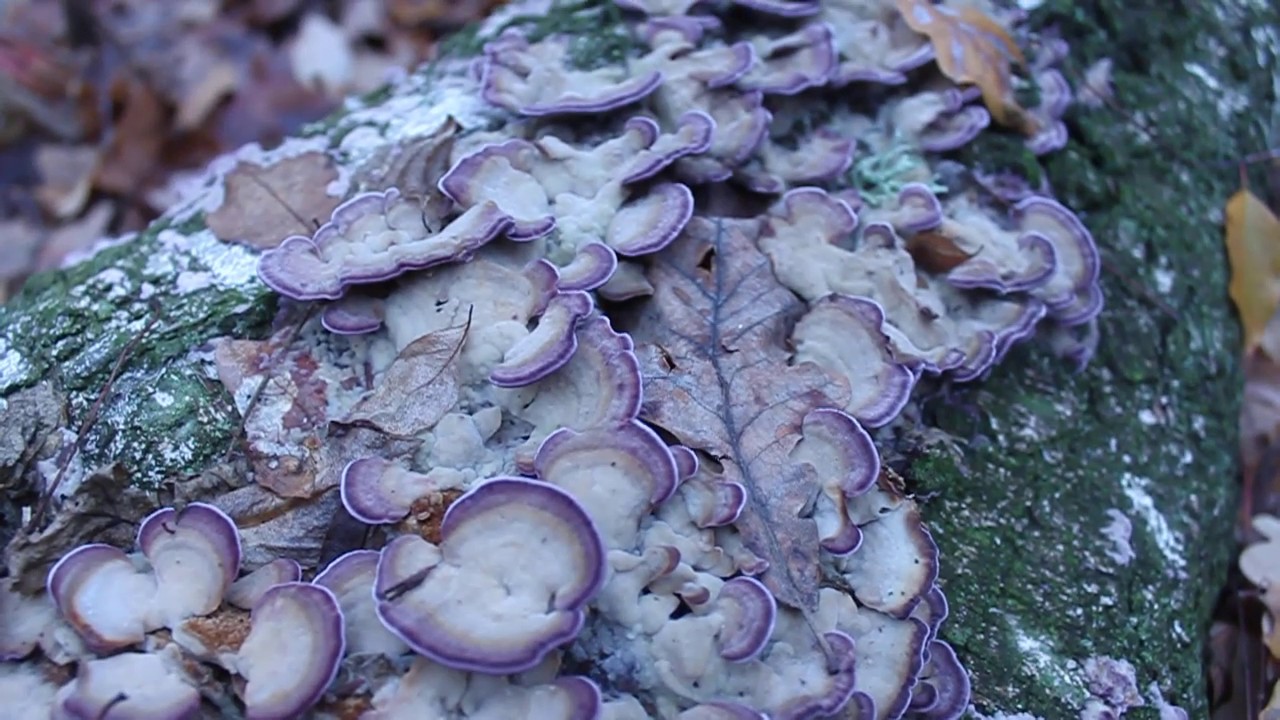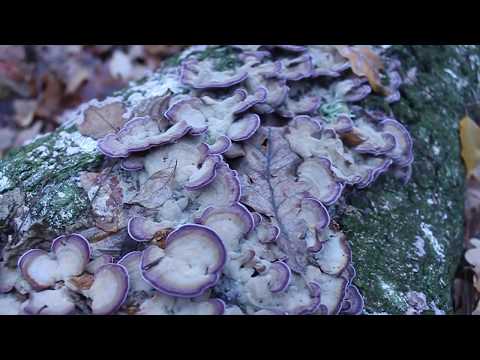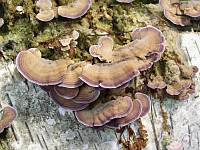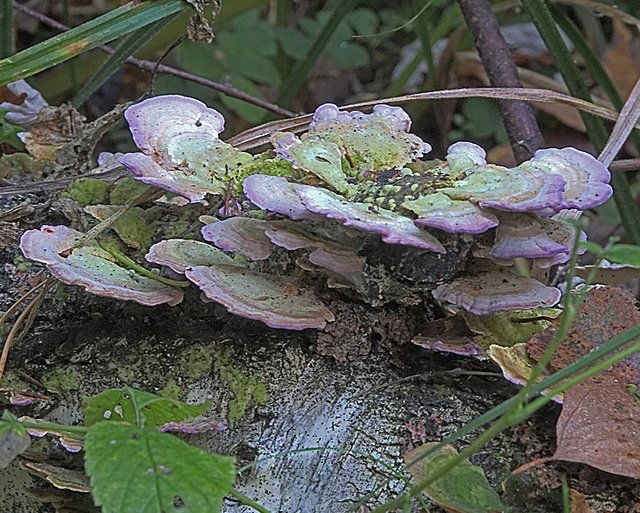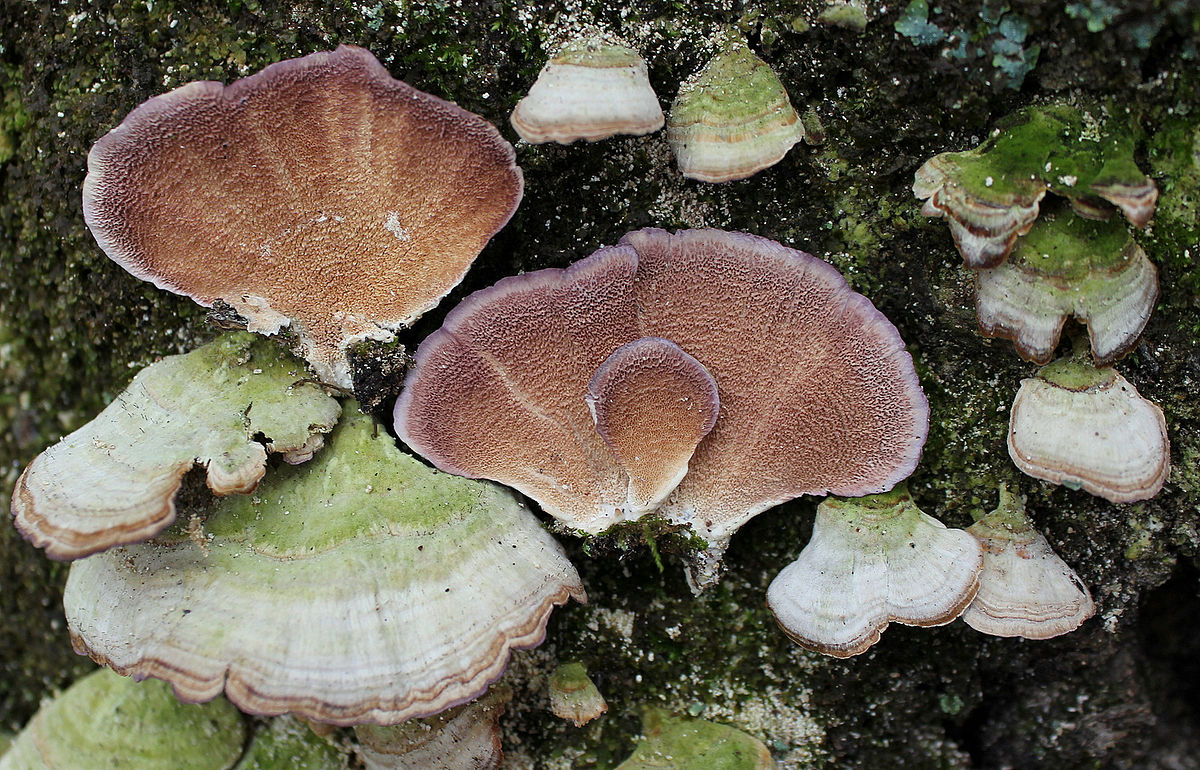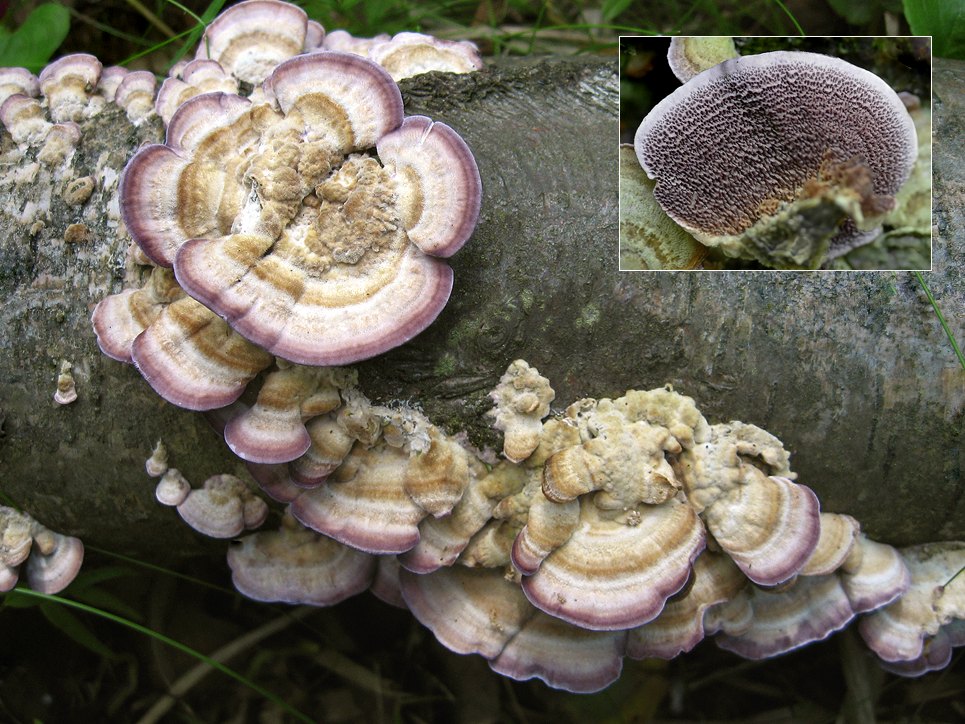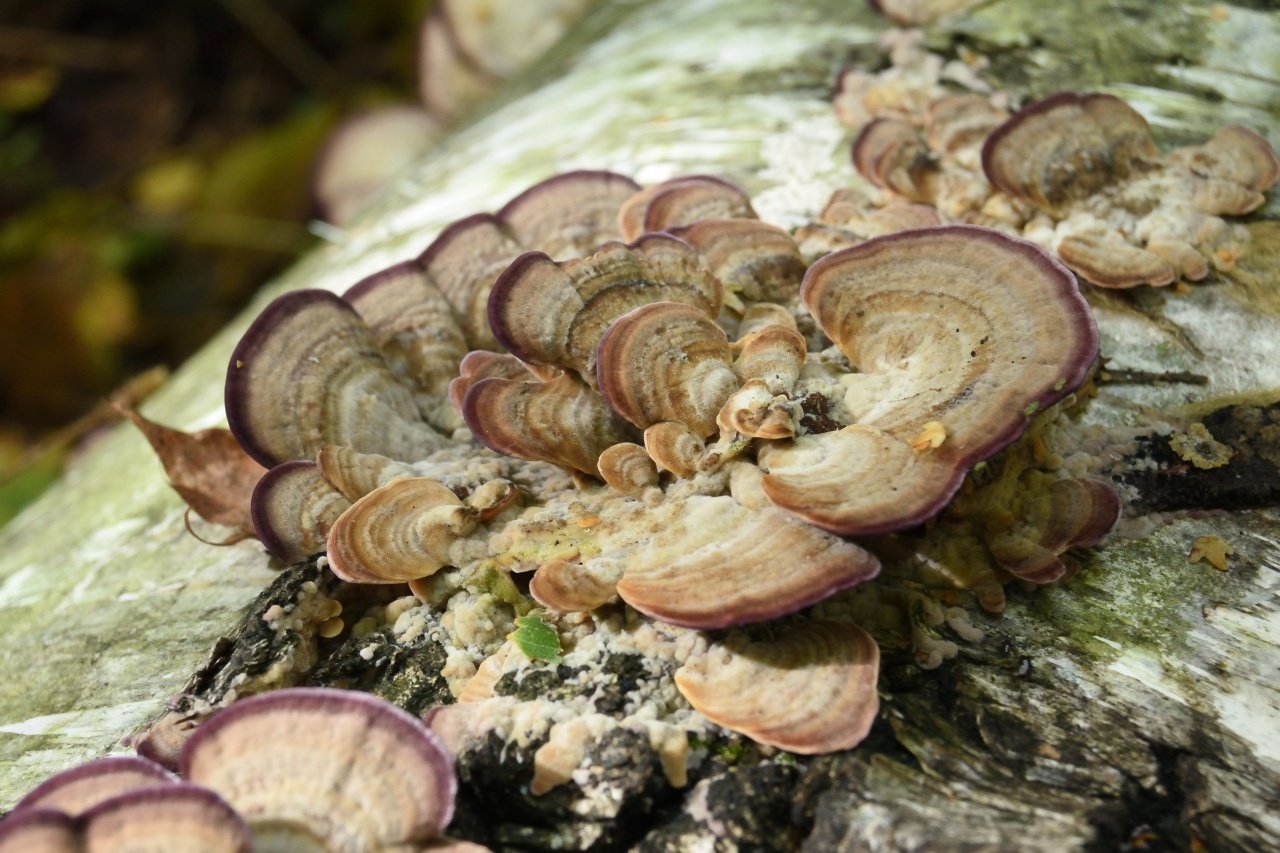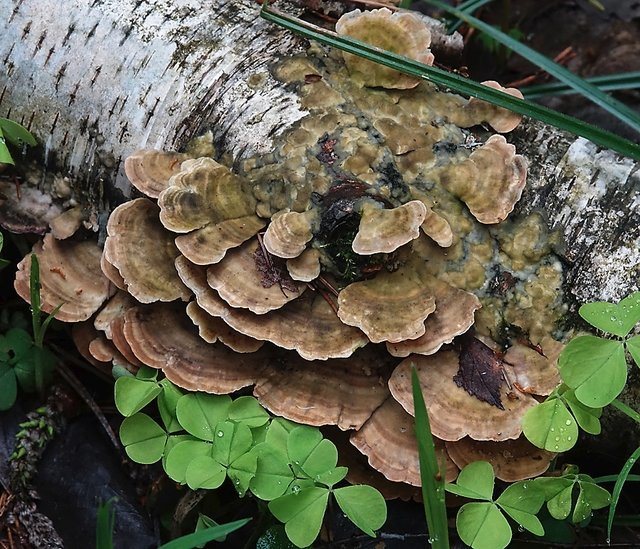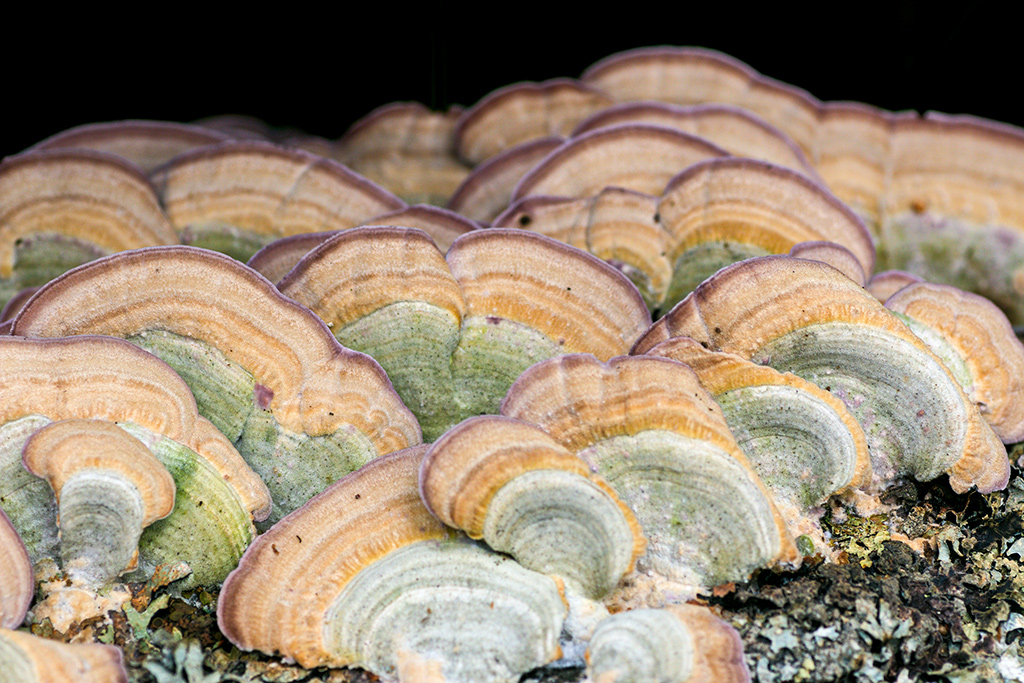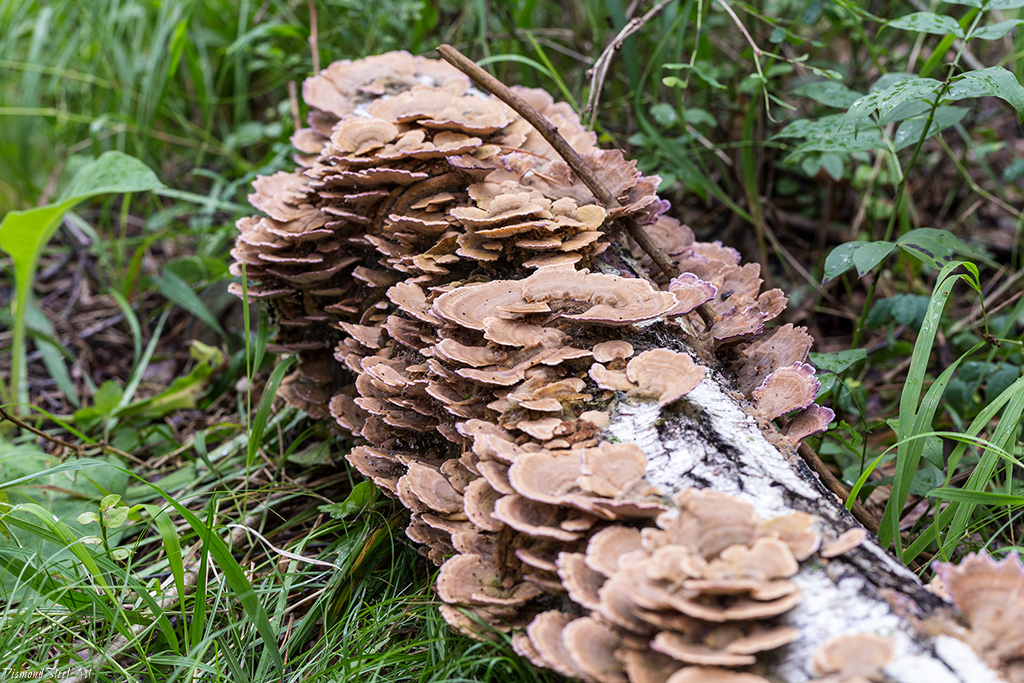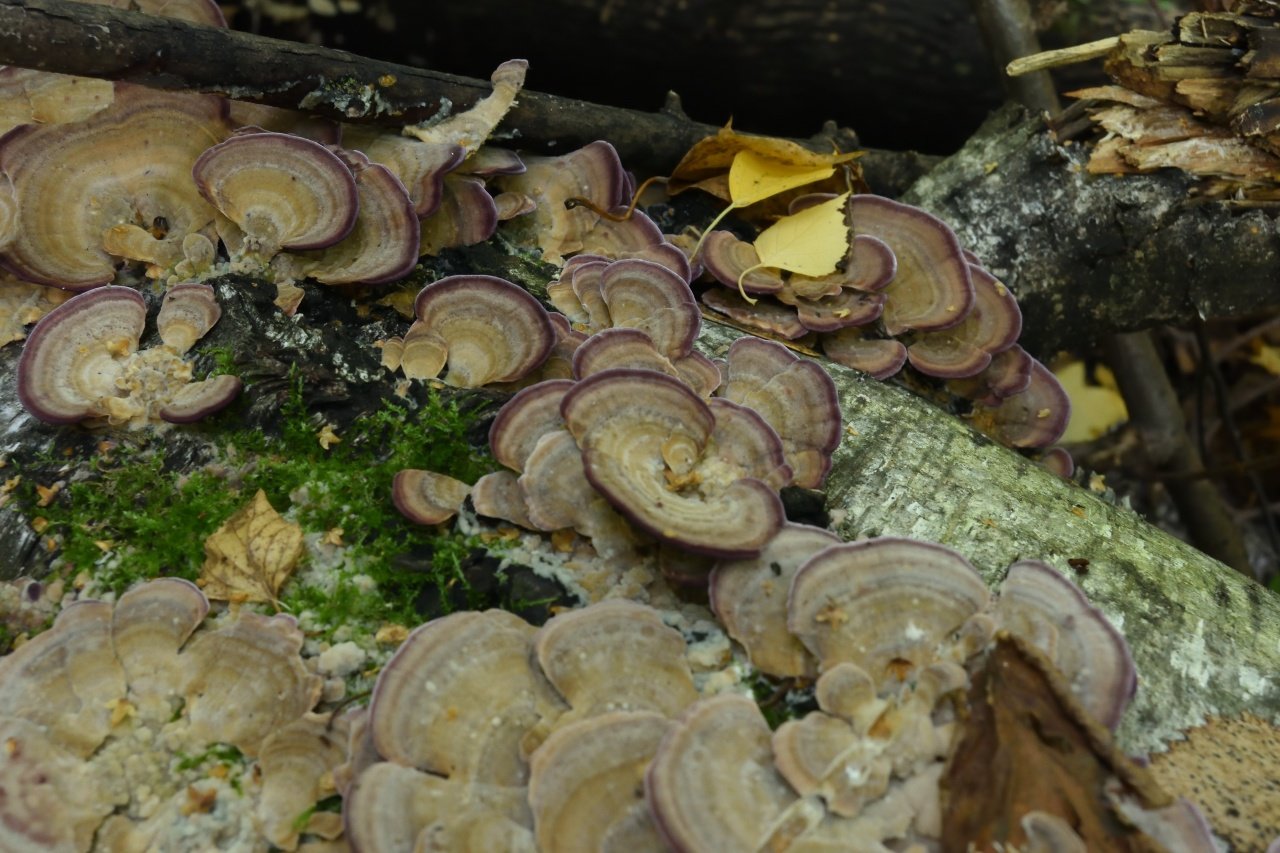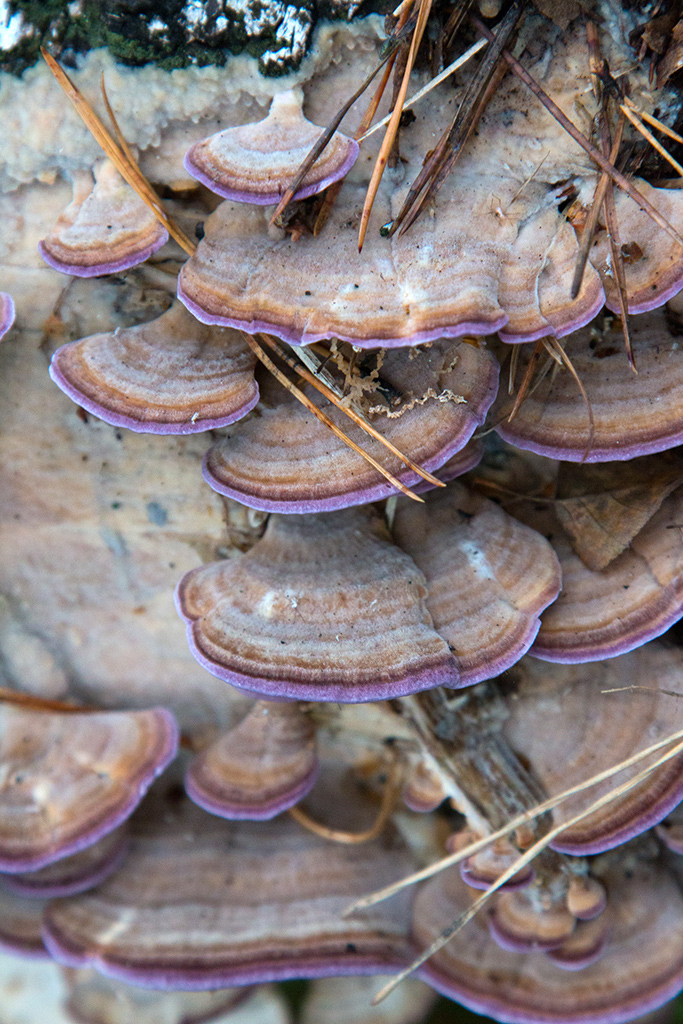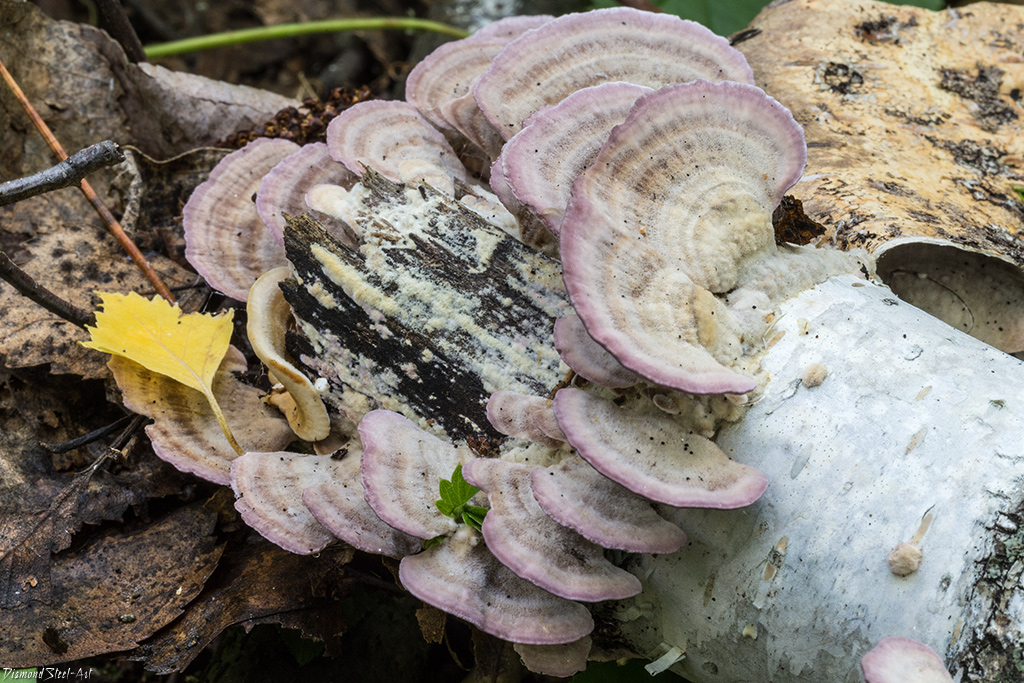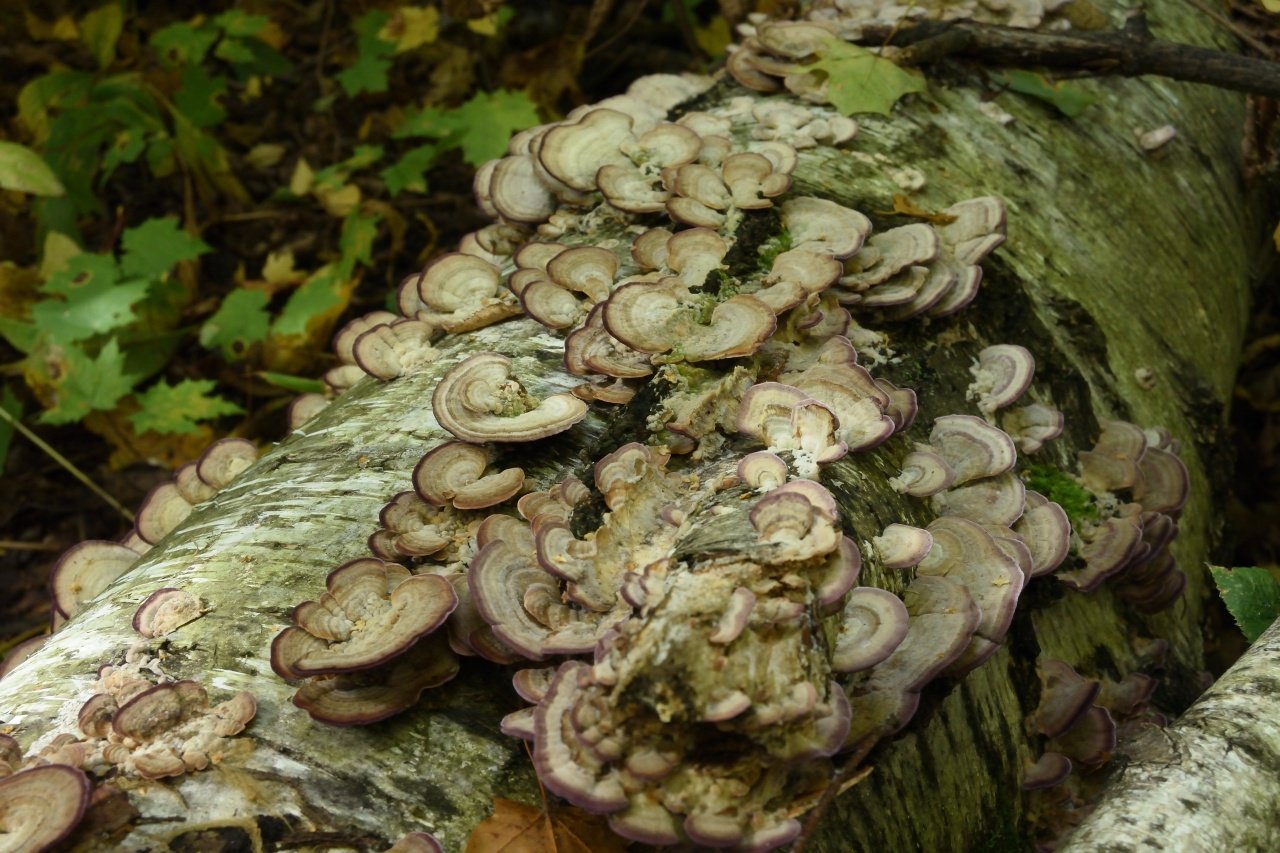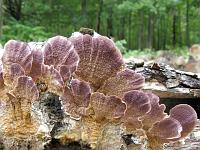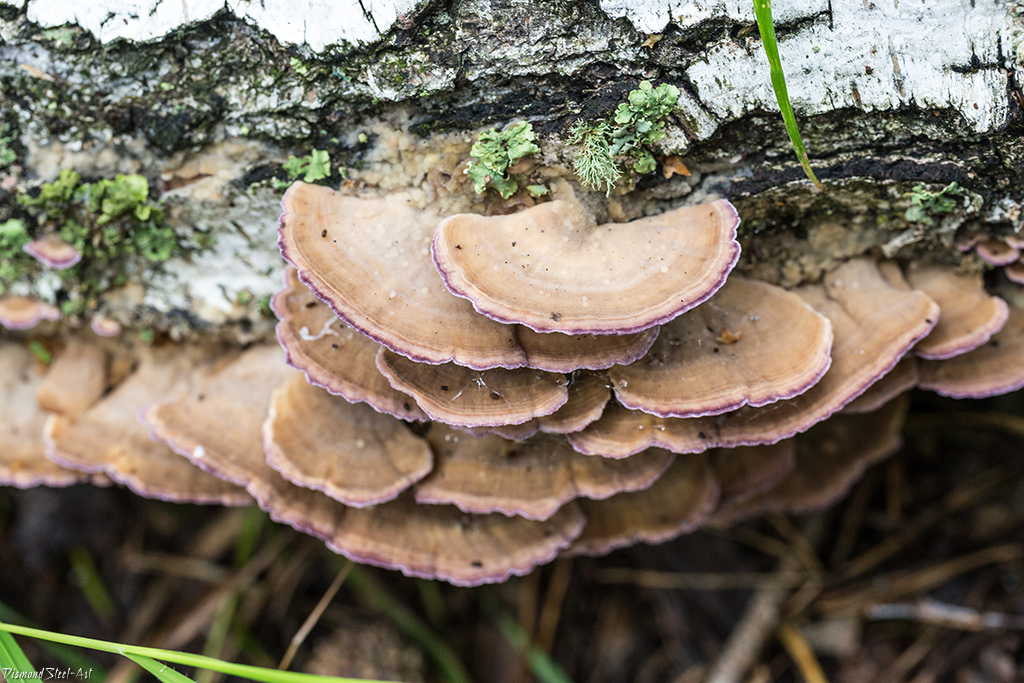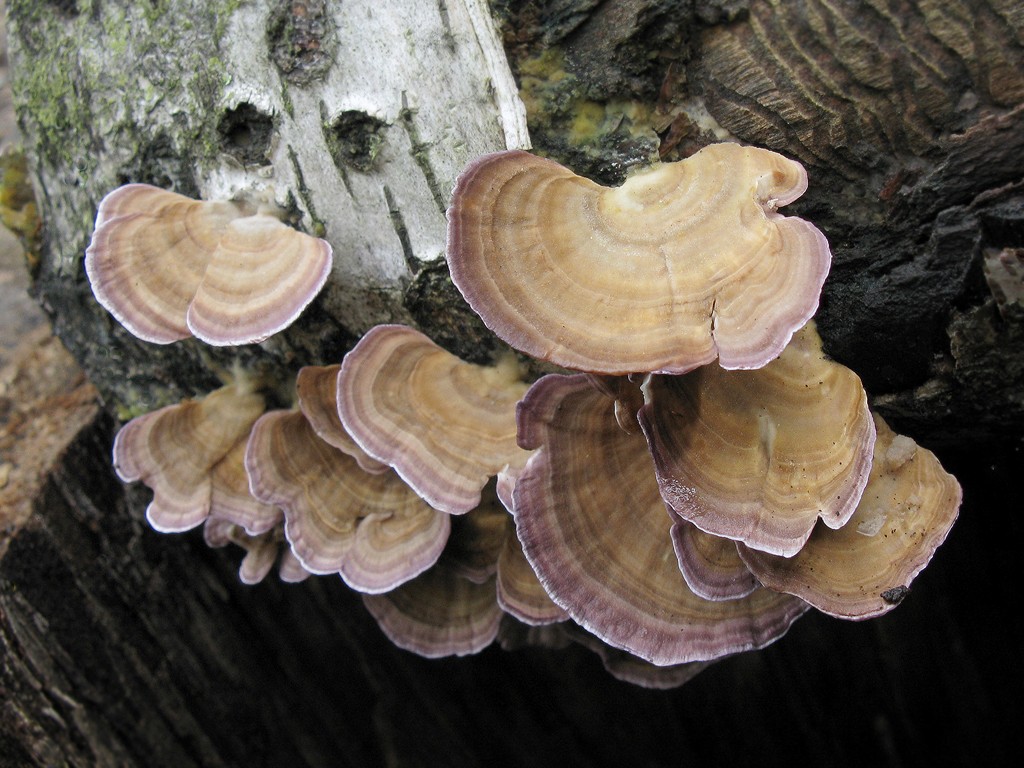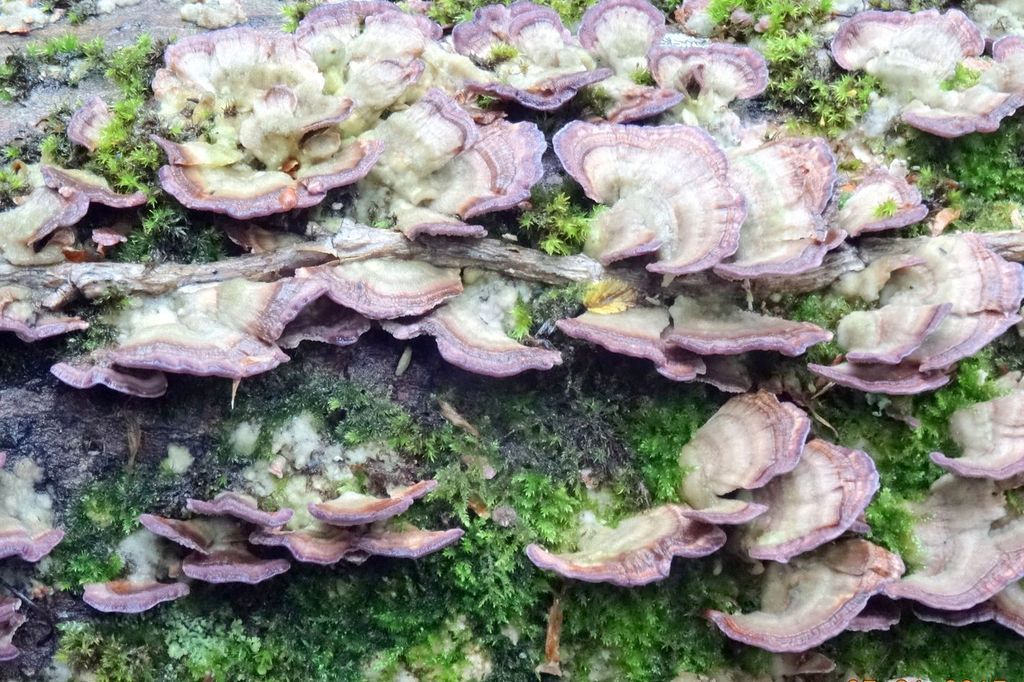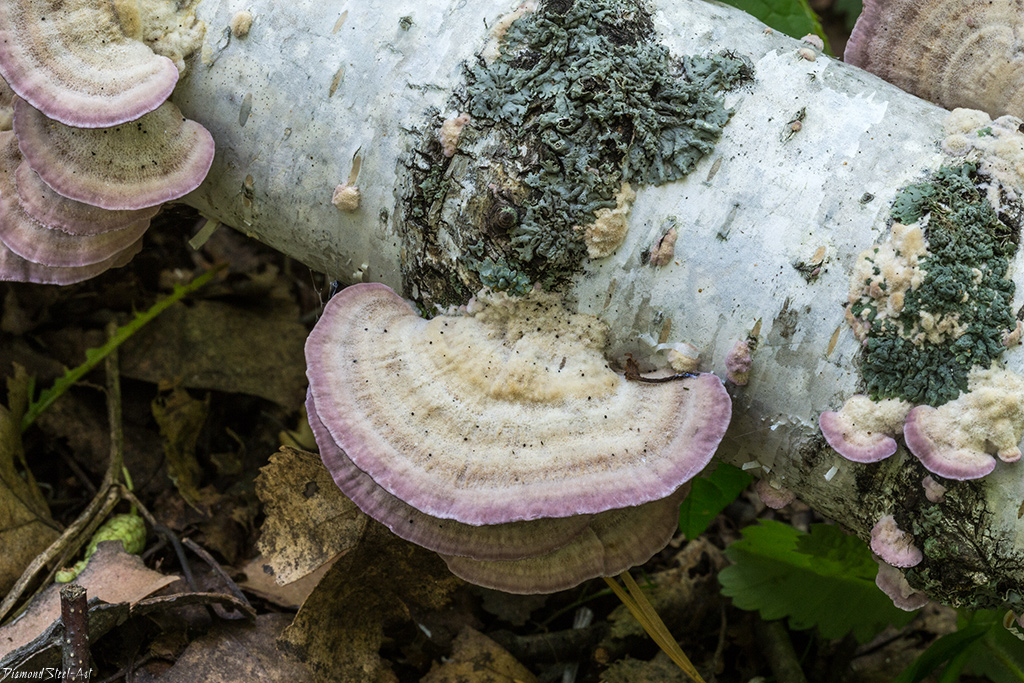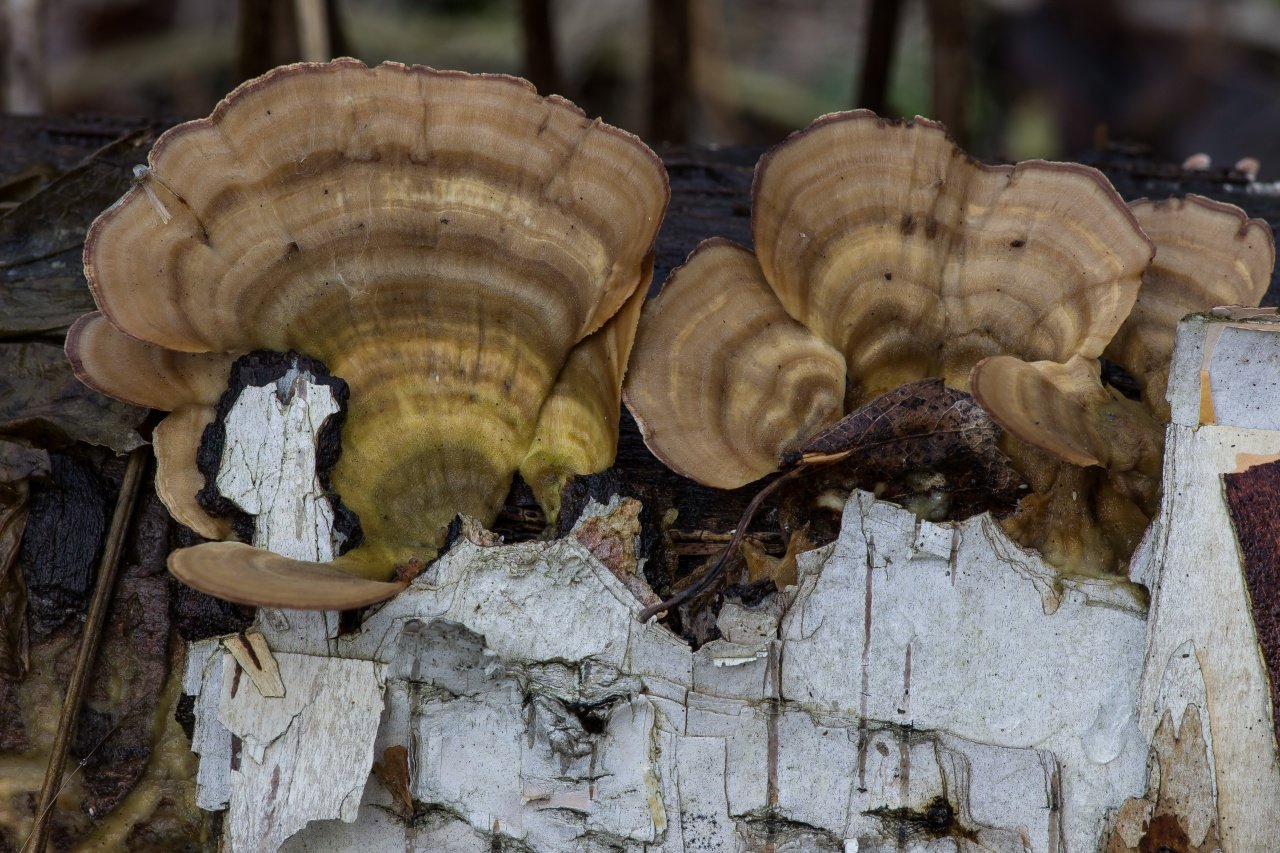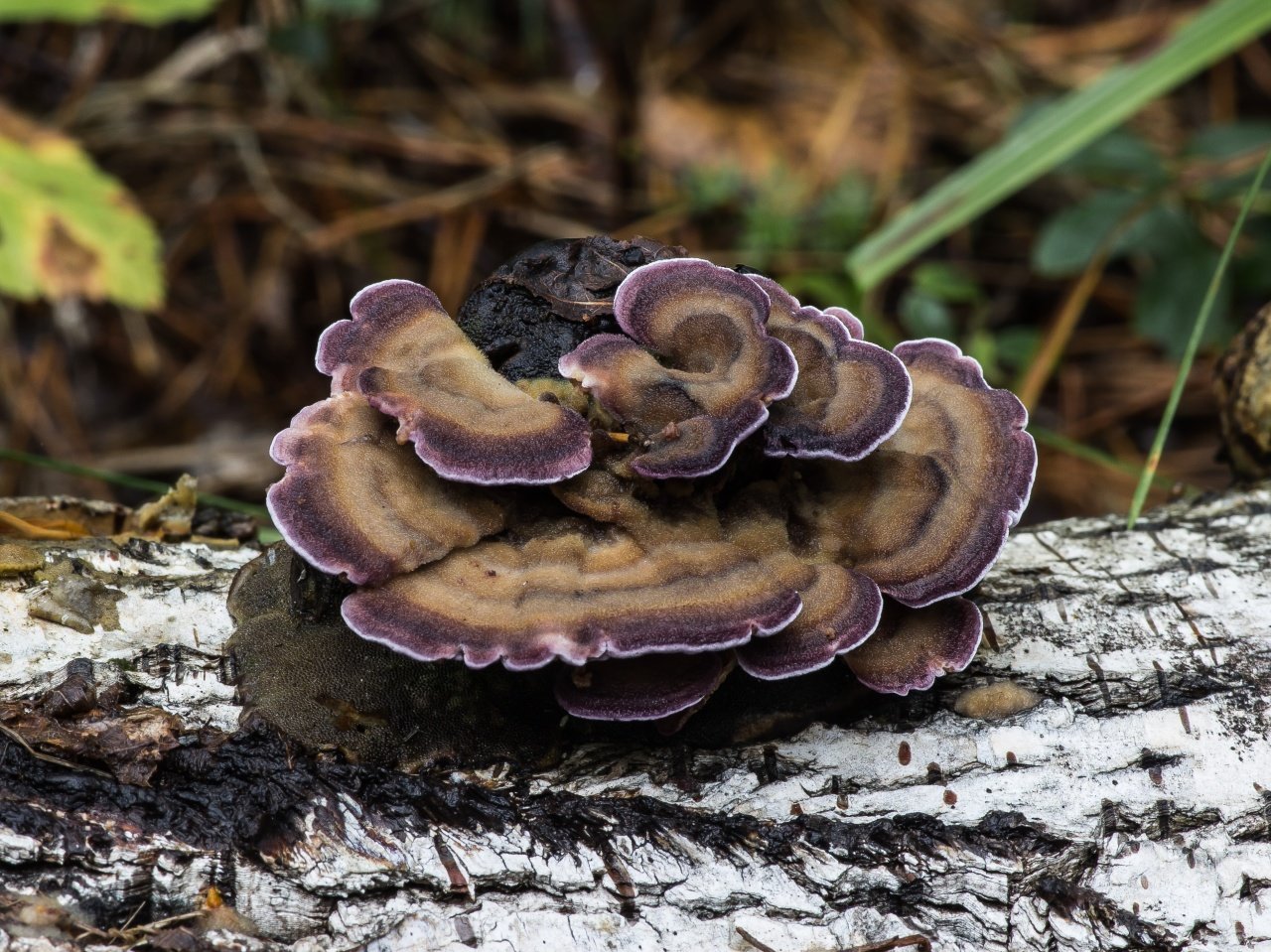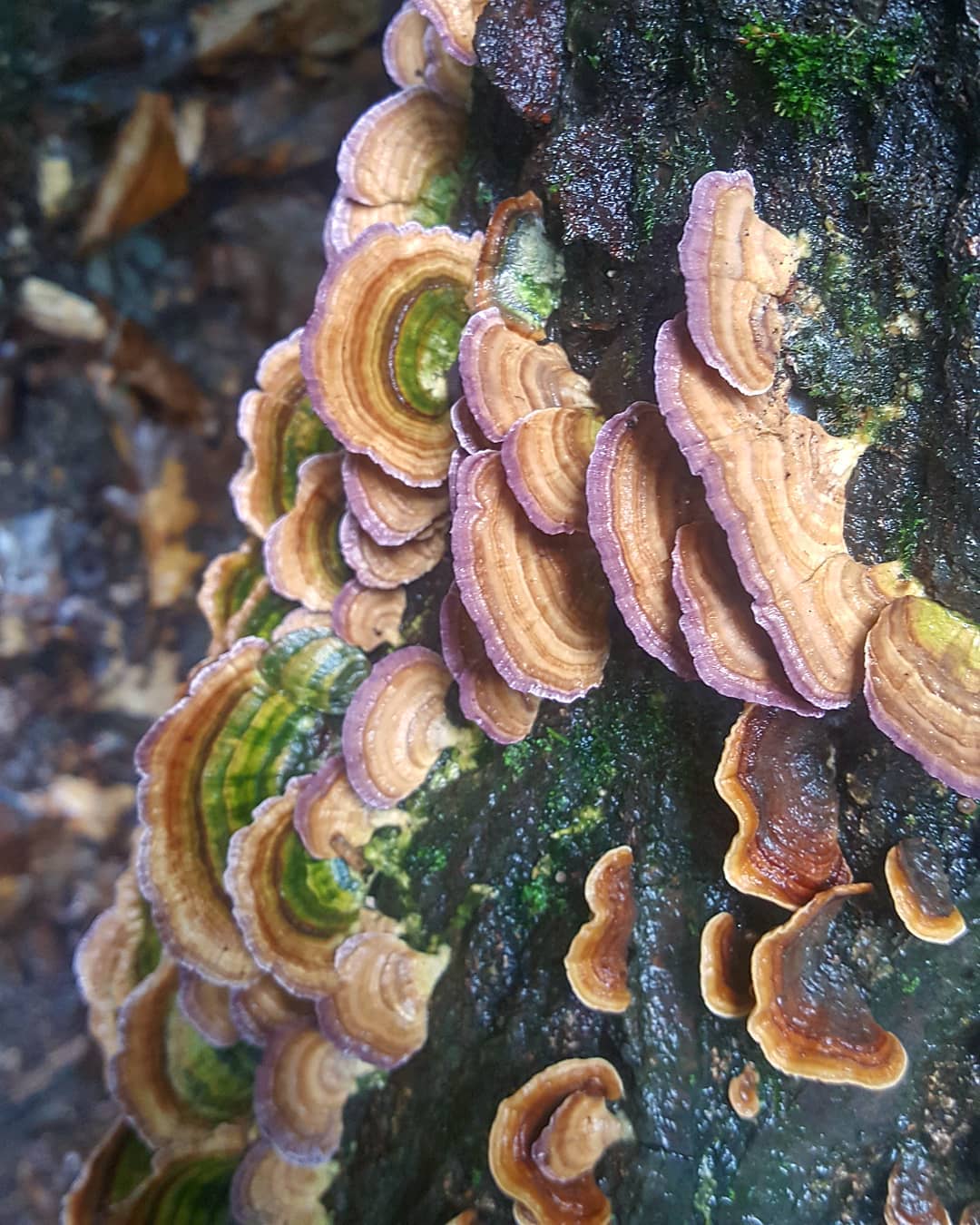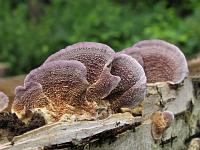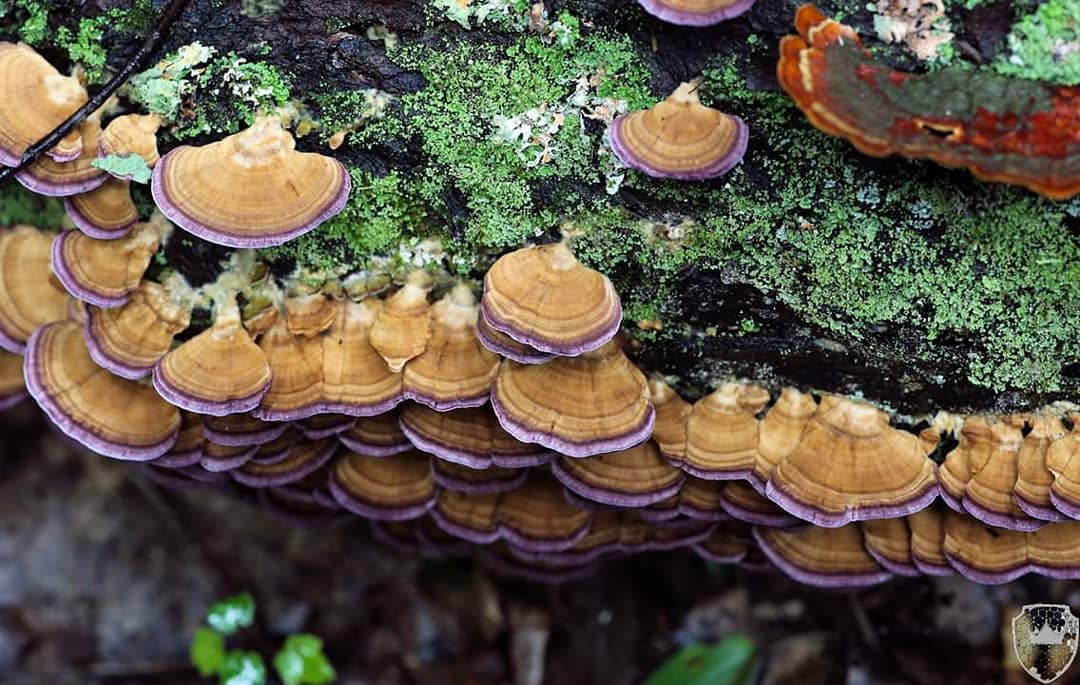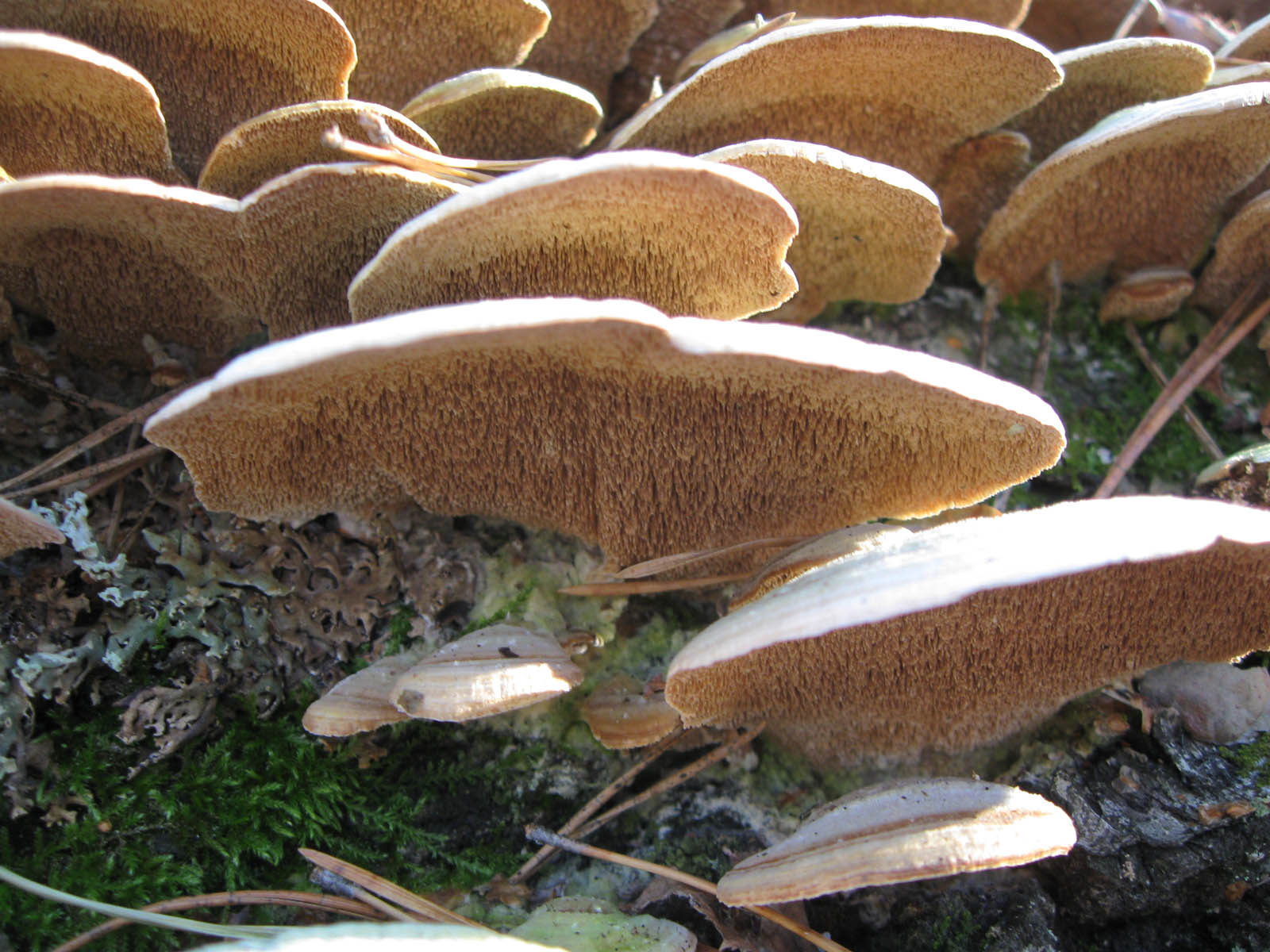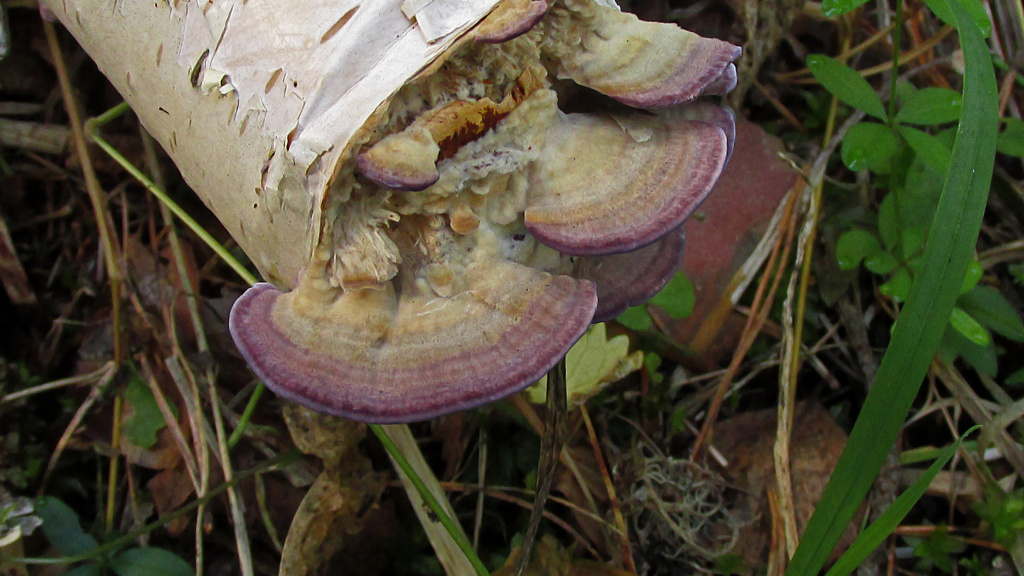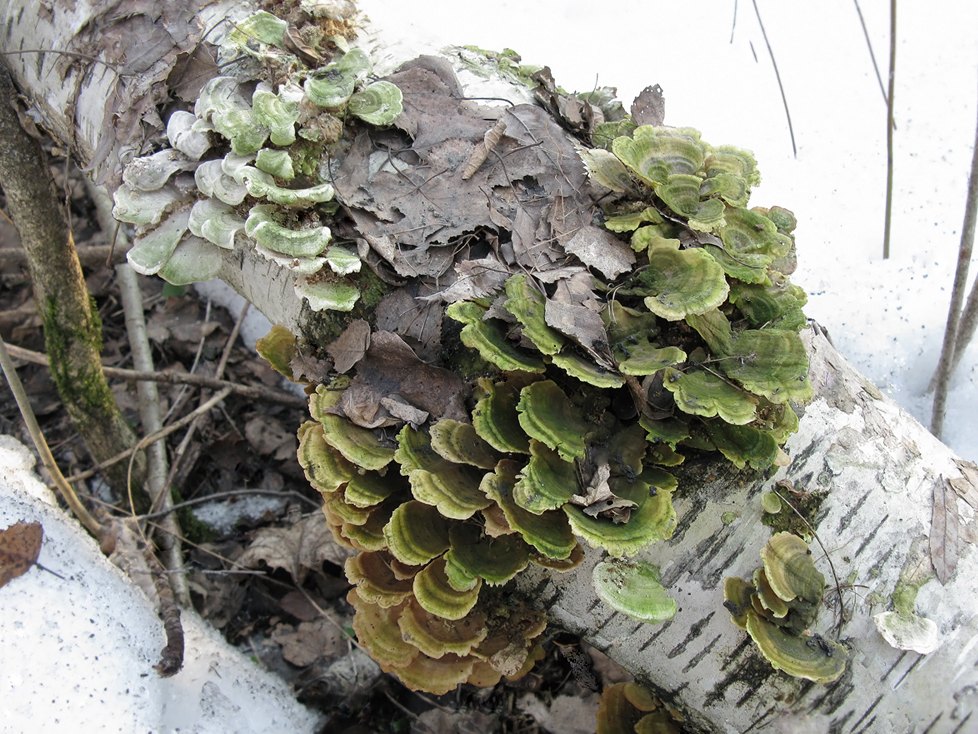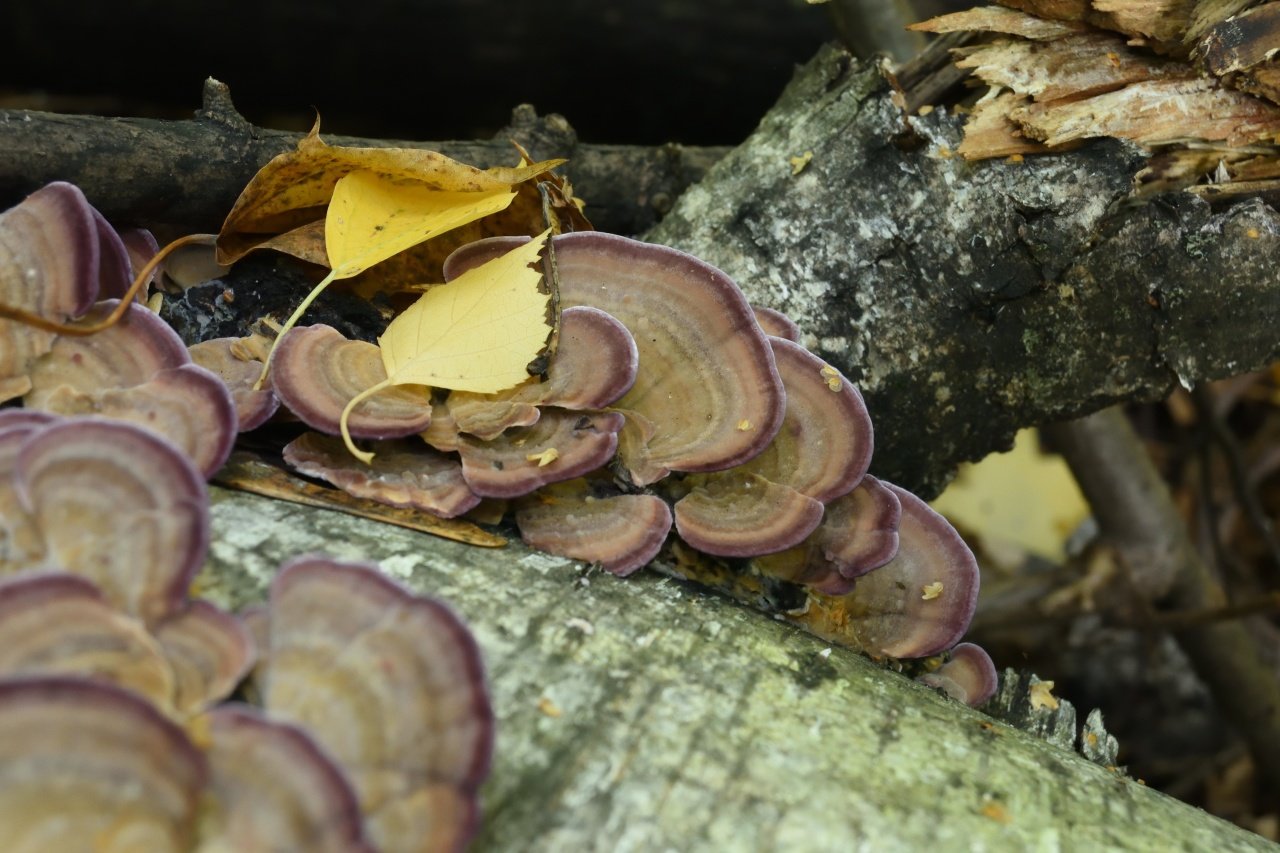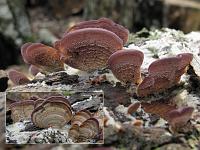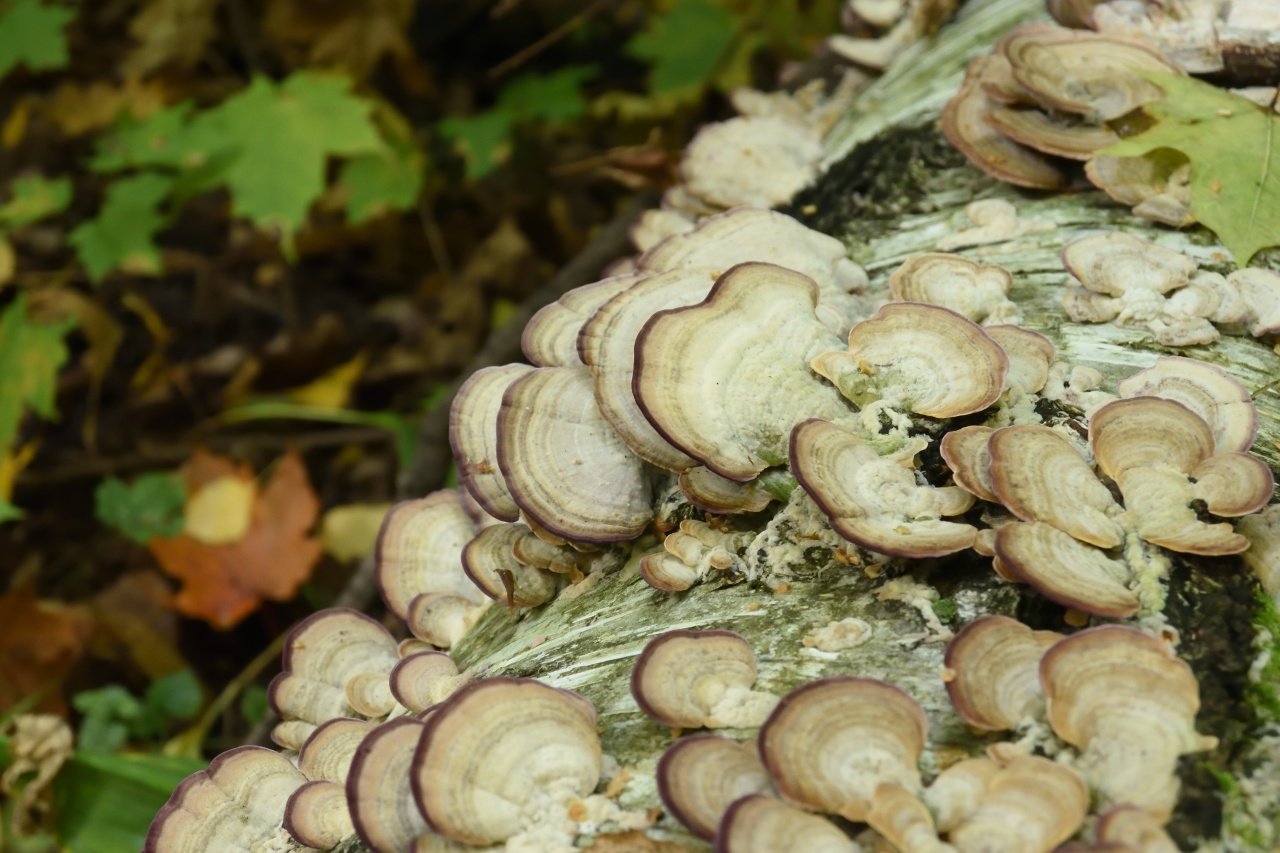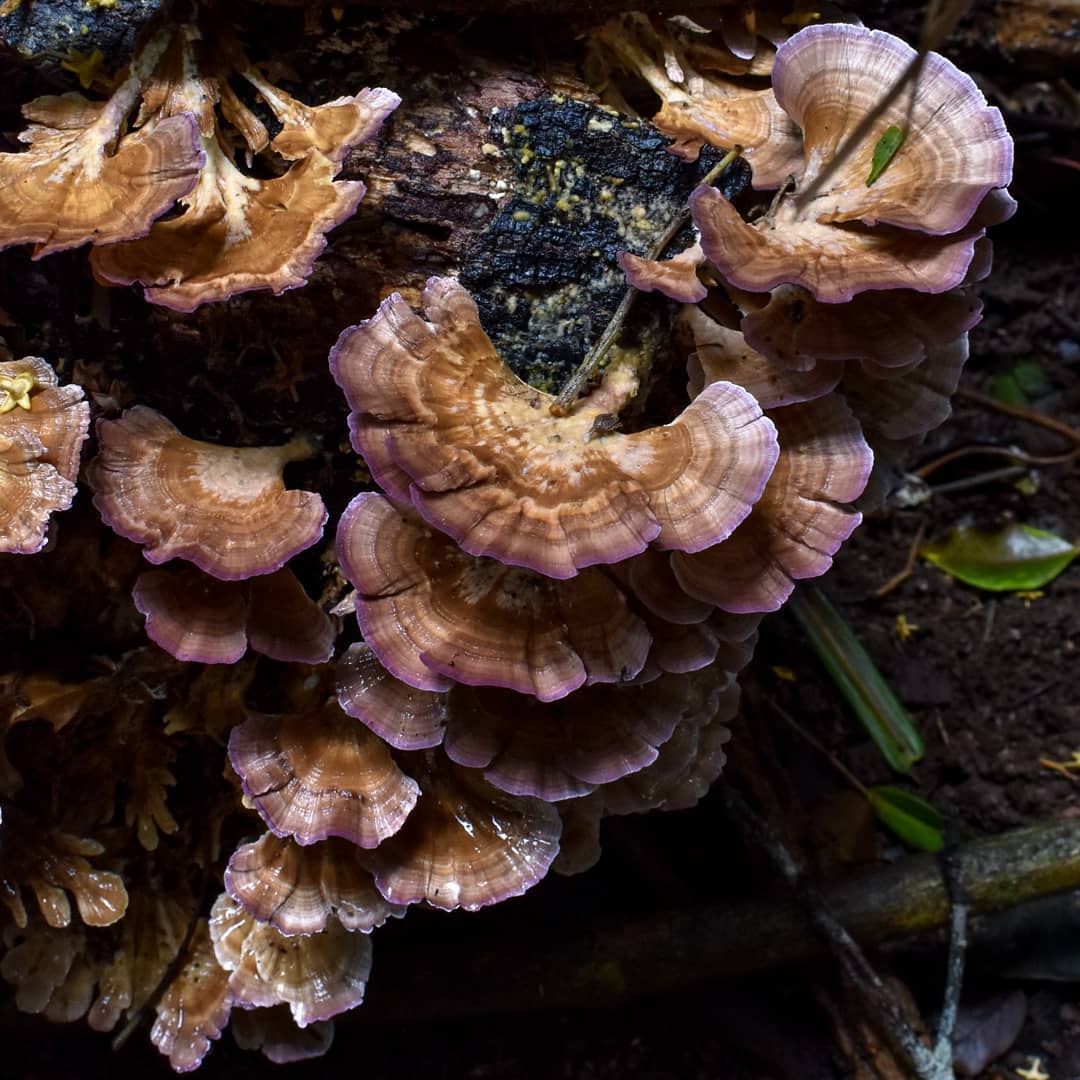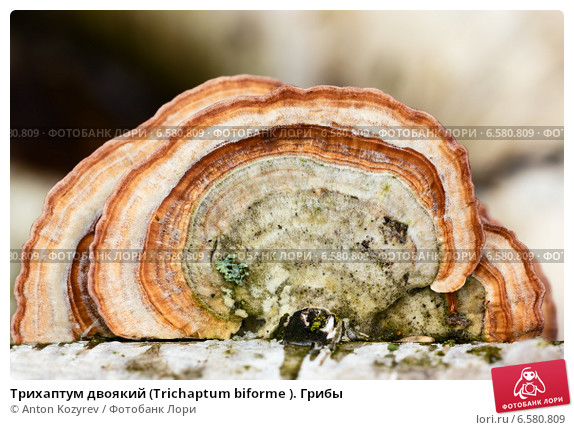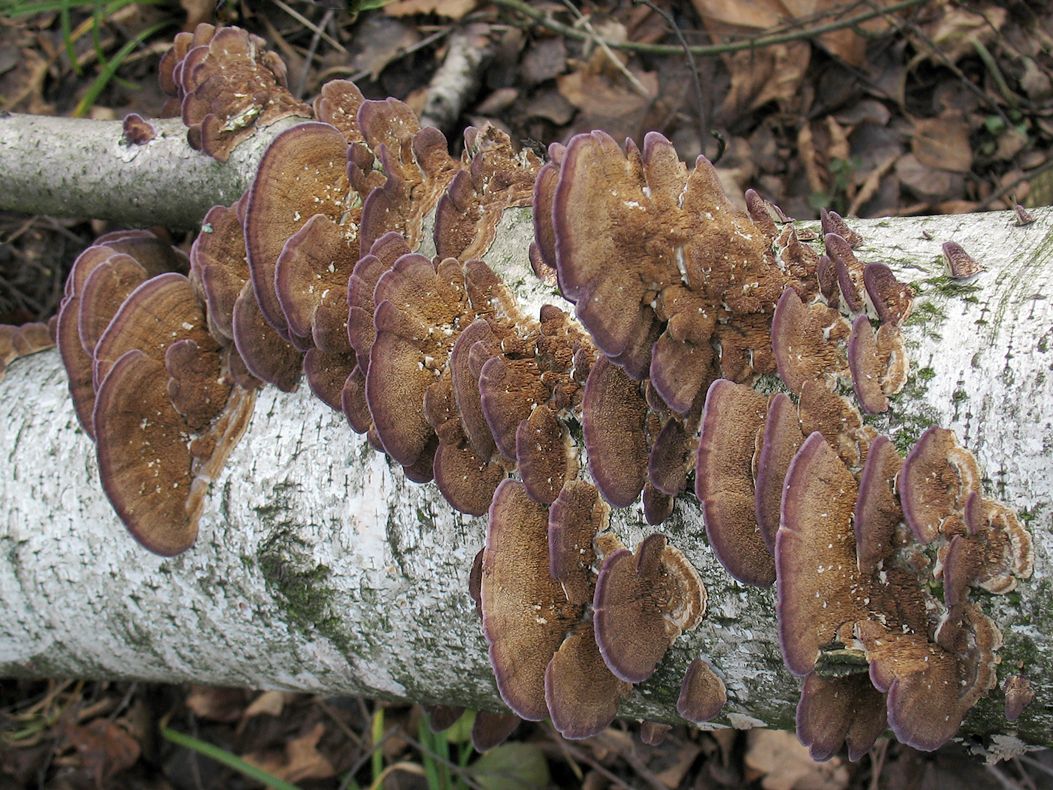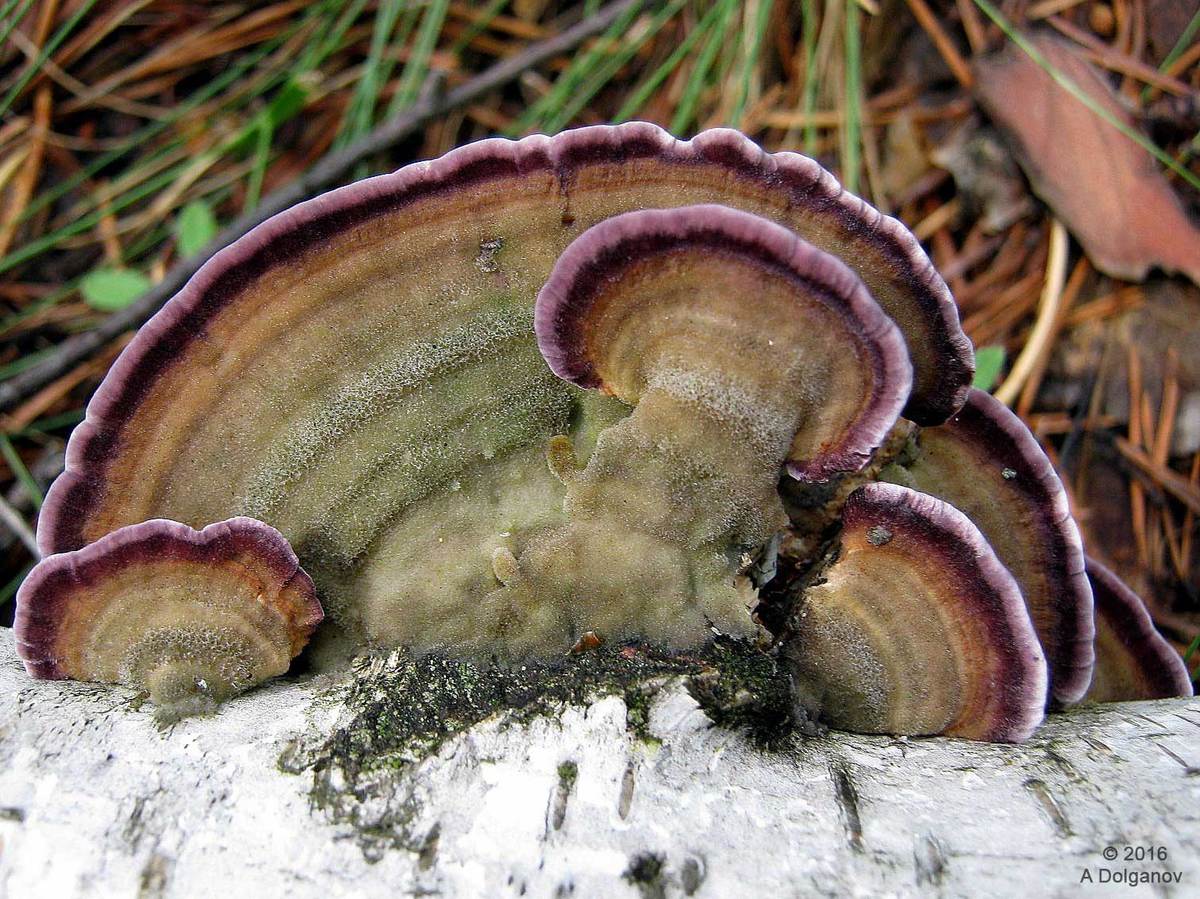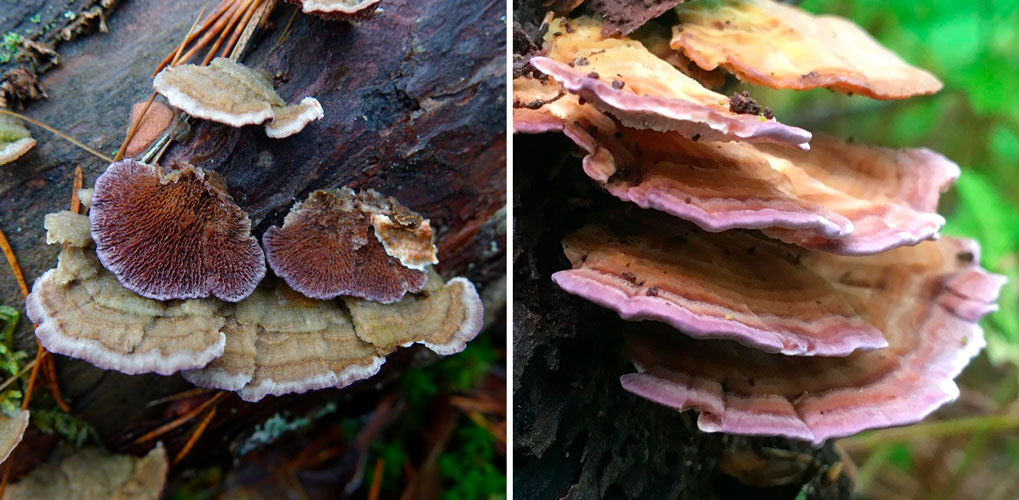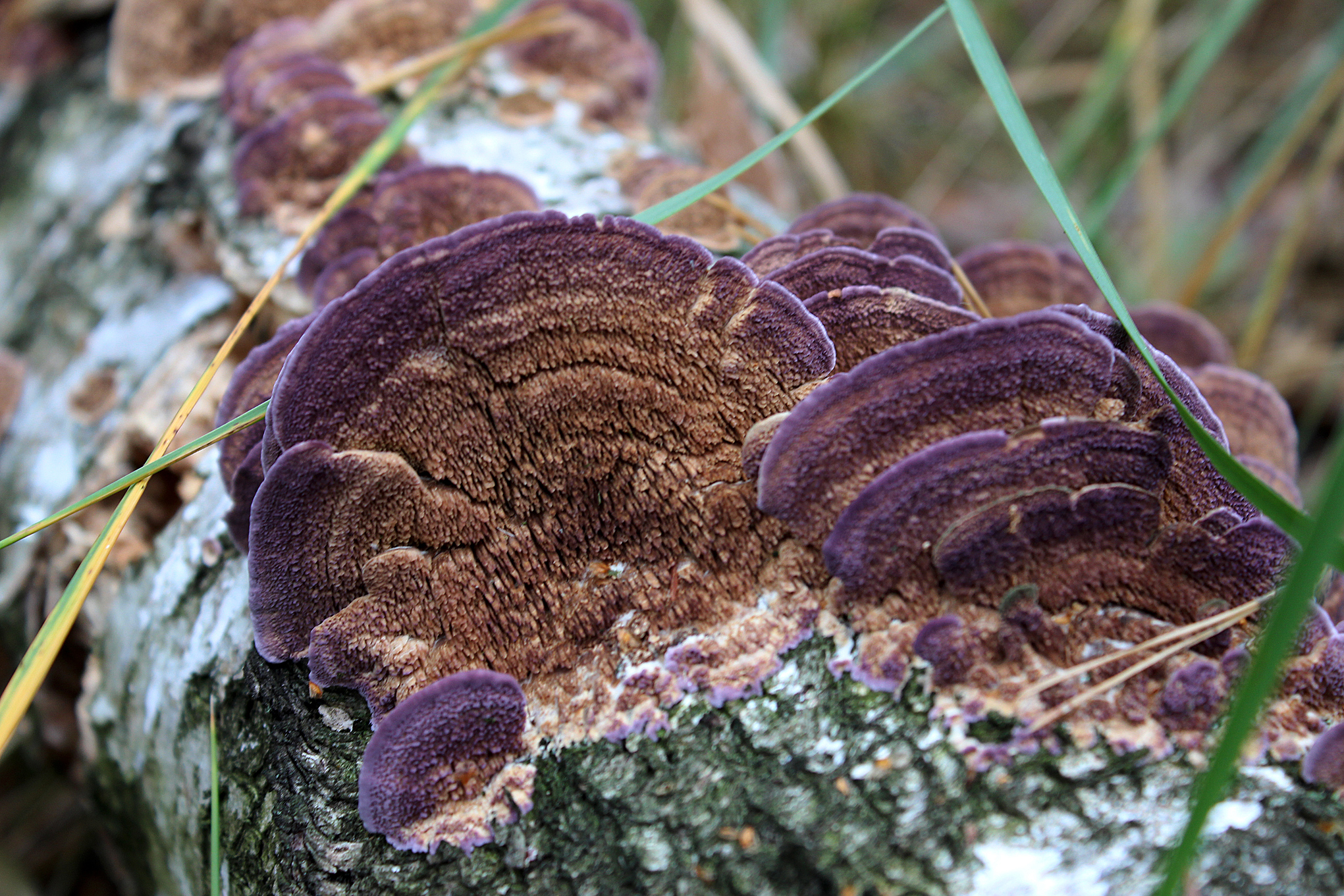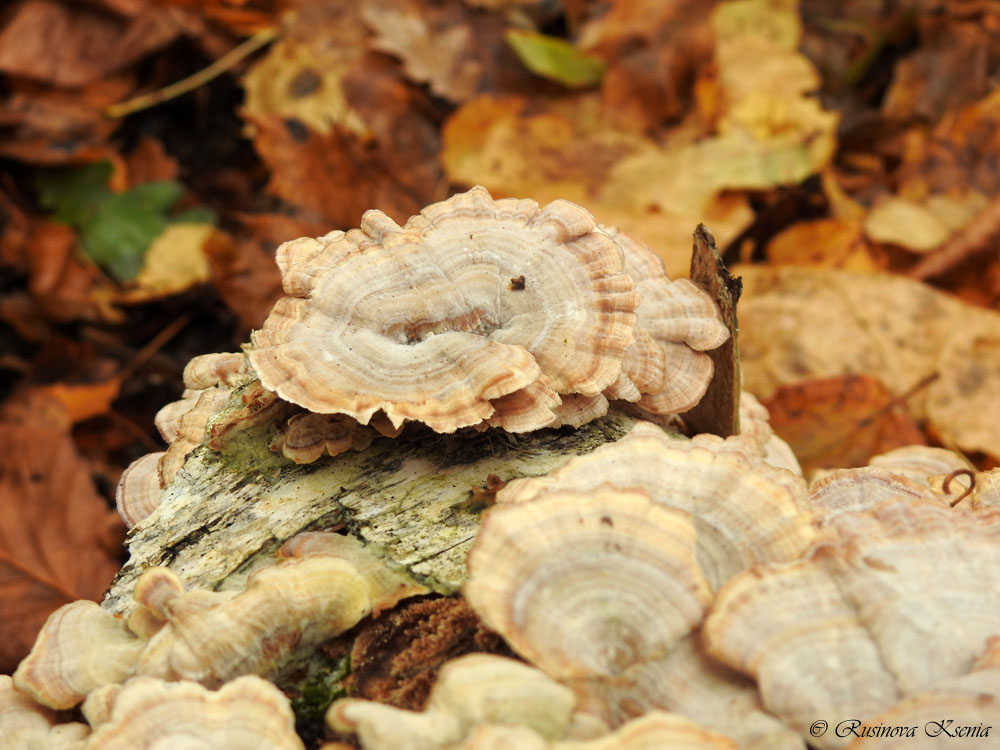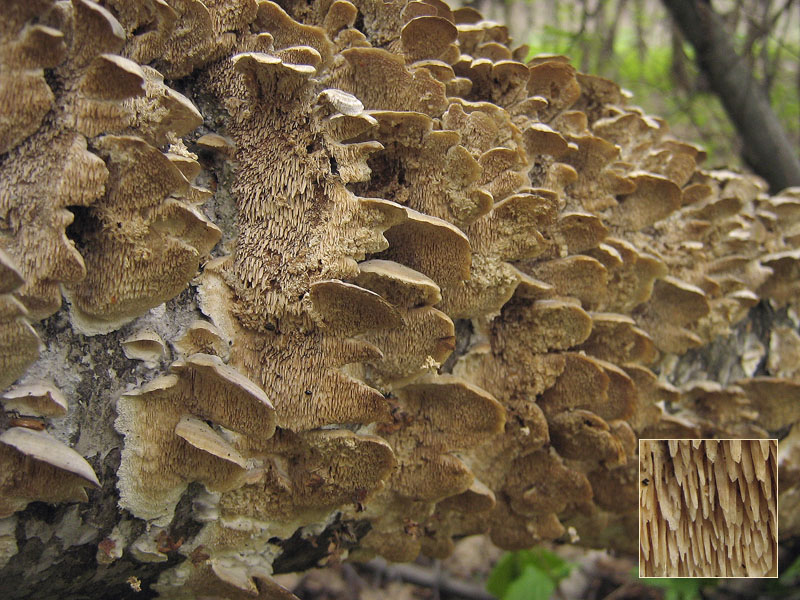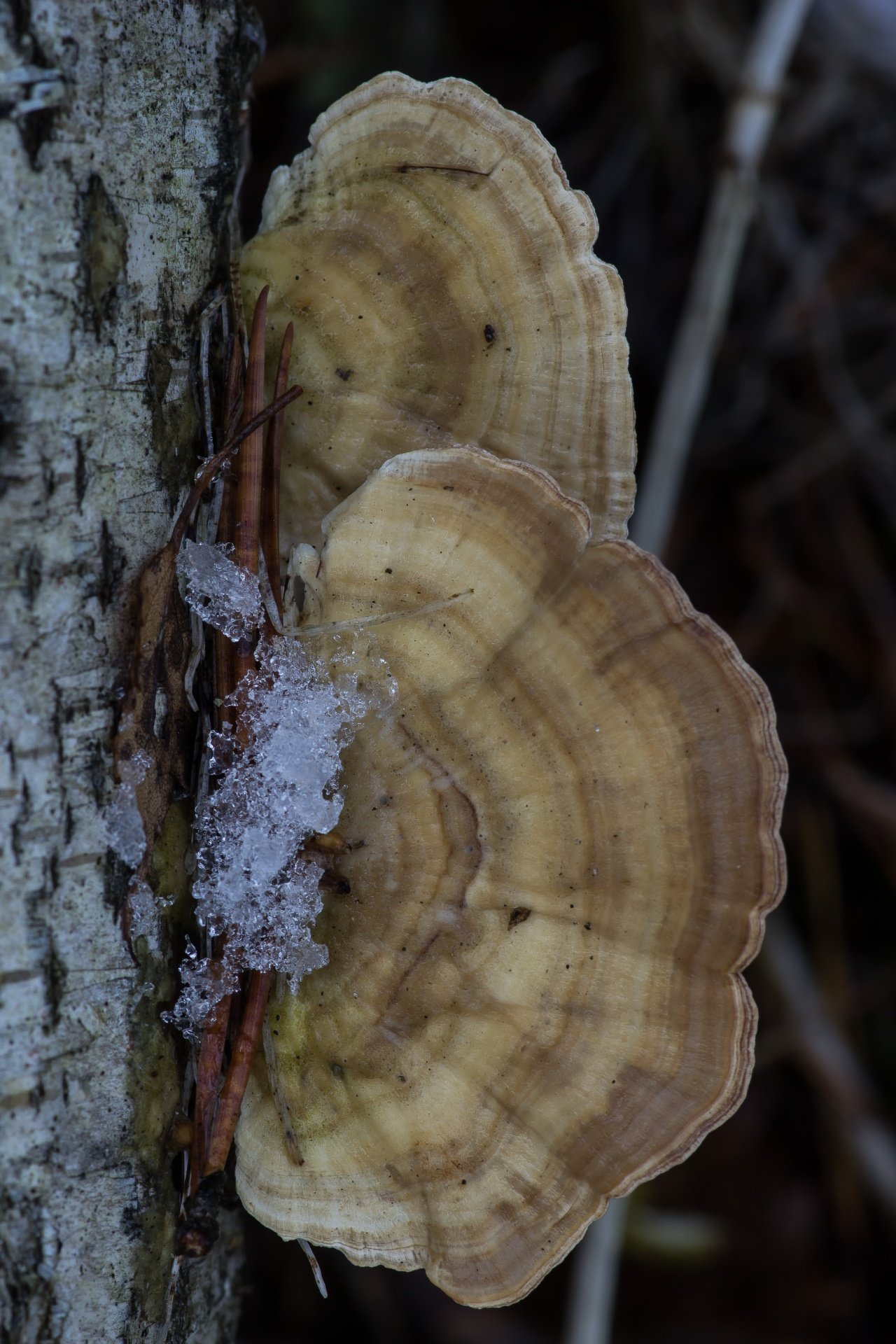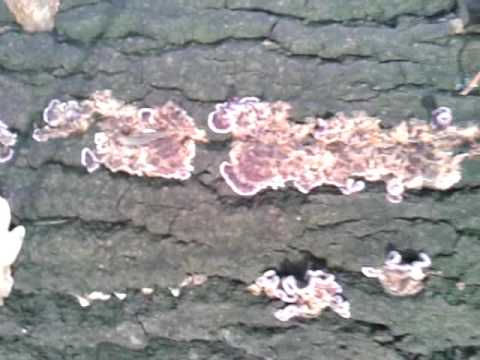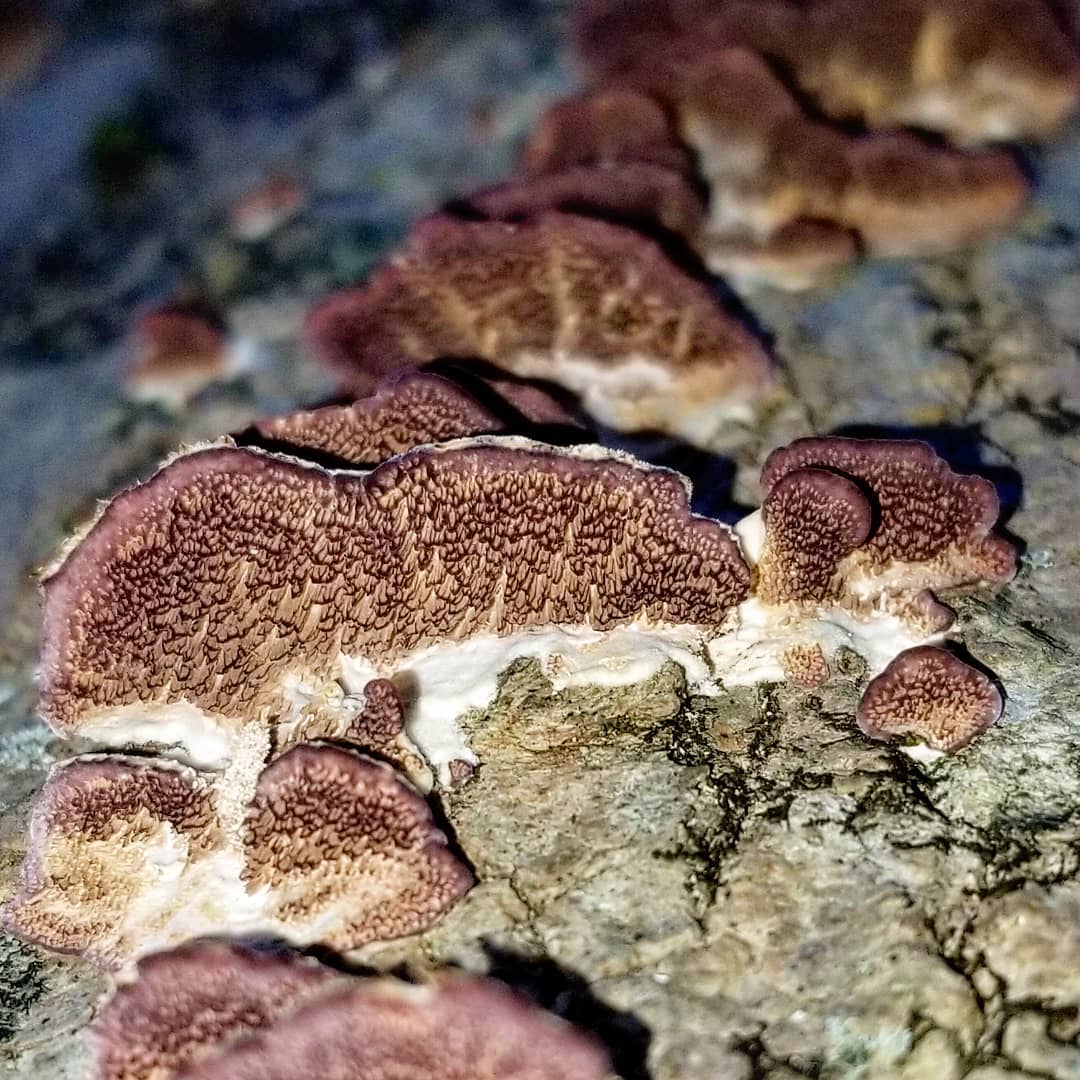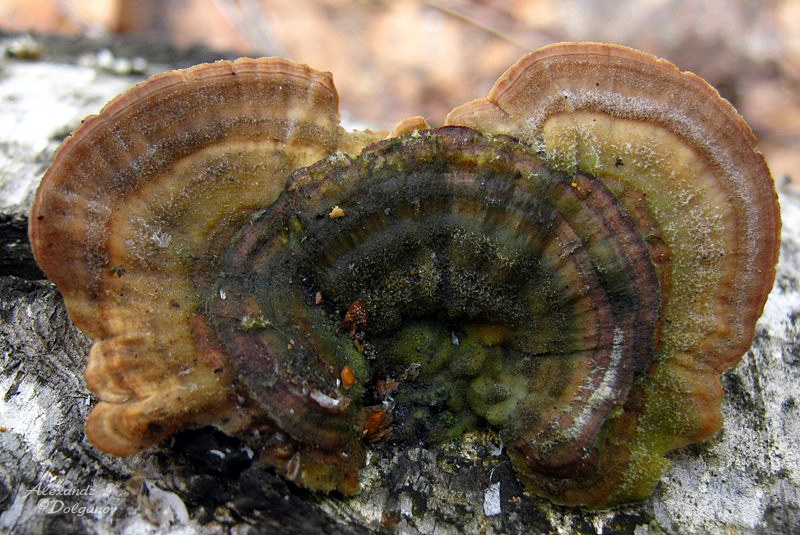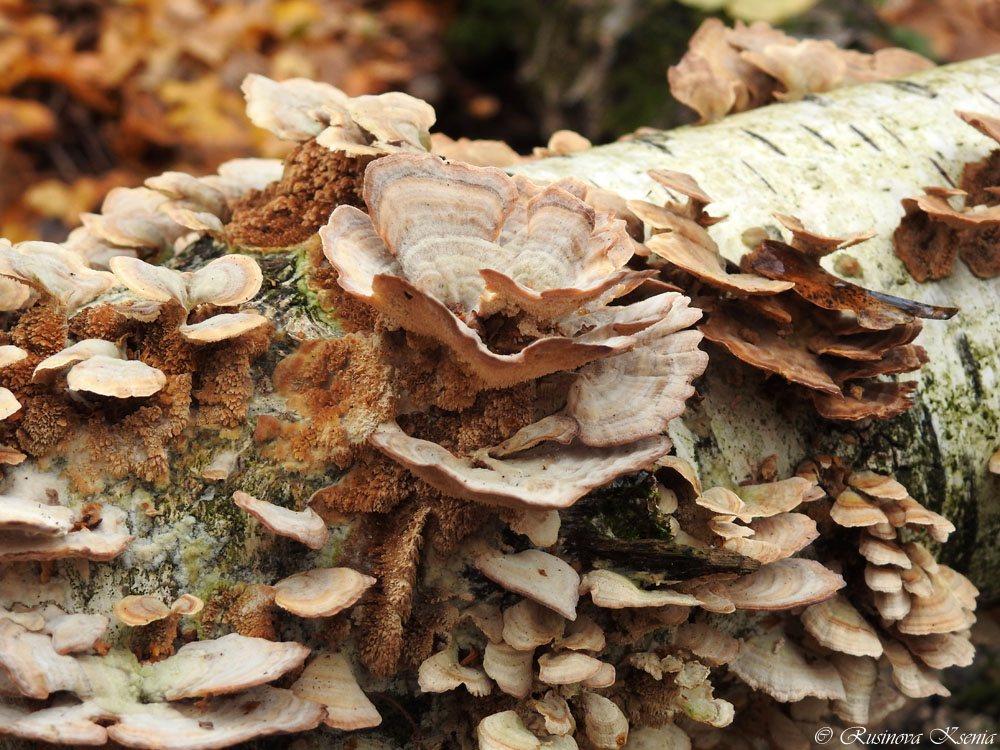Trichaptum chalk: photo and description
Spruce trichaptum is an inedible representative of the Polyporov family. Grows on moist, dead, felled coniferous wood. Destroying the tree, the fungus thereby cleans the forest from dead wood, turning it into dust and enriching the soil with nutrients.
What does Trichaptum spruce look like?
The fruiting body is formed by a flat cap with bent edges. It is attached to wood with a side surface. The mushroom has a semicircular or fan-shaped shape. The velvety surface is painted in gray tones with purple edges. In wet weather, due to the accumulation of algae, the color changes to light olive. With age, the fruiting body becomes discolored, and the edges are tucked inward.
The lower layer is painted in a pale purple color, as it grows, it becomes dark purple. The pulp is whitish, rubbery, tough, with mechanical damage the color does not change. Trichaptum spruce reproduces by microscopic cylindrical spores, which are located in a snow-white powder.
The fungus grows on dry spruce wood
Where and how it grows
Trichaptum spruce prefers to grow on rotten, dry coniferous wood in northern and central Russia, Siberia and the Urals. It grows everywhere, forming parasitic growths on the tree, which lead to the appearance of brown rot. The fungus damages forestry by destroying harvested timber and building materials. But, despite this, this representative is a forest orderly. Destroying and turning rotten wood into dust, it enriches the soil with humus and makes it more fertile.
Trichaptum spruce bears fruit from spring to late autumn. The development of the fruiting body begins with the appearance of a brown or yellowish spot. Further, at this place, light brown blotches of an oblong shape appear. After 30-40 days, the blotches are filled with a whitish substance, forming voids.
In the place of active growth of the fruit body, the destruction of the tree occurs, which is accompanied by abundant resinification. The fungus continues its development until the wood is completely destroyed.
Is the mushroom edible or not
Spruce Trichaptum is an inedible forest dweller. Due to its hard, rubbery pulp and lack of taste and smell, it is not used in cooking.
Doubles and their differences
Spruce trichaptum, like any representative of the mushroom kingdom, has similar twins. Such as:
- Larch is an inedible species, grows in the taiga, prefers to settle on rotten, dry conifers and stumps. The fruiting body is prostrate, the cap, 7 cm in diameter, has the shape of a shell. The grayish surface has a silky, smooth skin. It grows more often as an annual plant, but biennial specimens are also found.
Due to the rubbery pulp, the species is not used in cooking.
The mushroom is inedible, but due to its beautiful surface, it is suitable for a photo shoot
The mushroom has a beautiful shell-shaped surface
Conclusion
Trichaptum spruce prefers to grow on dead coniferous wood, causing brown rot on it. This type causes great damage to building material, if the storage rules are not followed, it quickly collapses and becomes unusable for construction. It grows from May to November, because of the tough, tasteless pulp, it is not used for cooking.
Fern Eagle
One of the most famous and widespread Ferns on the planet is the Orlyak fern - a beautiful bright plant, it can decorate any corner in the garden, forest or near a pond.
The culture is used in folk medicine - a decoction from the shoots is used to relieve stress, remove radionuclides, eliminate fever, and strengthen the skeleton. The decoction of the roots has an anthelmintic effect, relieves joint aches, and helps with diarrhea.
The main characteristics of the culture:
What does the bracken fern look like? Common bracken is a perennial herb of the Dennstedtiye family. A distinctive feature when describing a fern is frond, shaped like the wings of an eagle with tips curled inward. Usually Orlyak reaches 70 cm in height, but in more favorable climatic conditions (Primorsky Krai) it grows above a meter. The root system is well developed, deeply located, due to which the plant grows quickly, adapts to any climatic features - the roots do not freeze, they are not afraid of drought, rainfall and even fires.
Where does the bracken fern grow? The culture is found in all corners of the globe, except for Antarctica and the desert, and is widespread in Russia: in the middle zone, in Siberia, the Urals, the Far East, and the Primorsky Territory. Habitat - coniferous (pine) and deciduous (birch) forests, as well as edges, hills, water bodies. It grows well on pastures, clearings, abandoned fields. Prefers sandy, light soil, limestone. In some countries, the fern multiplies at such a fast rate that it is fought like a weed.
How to grow Orlyak at home? Fern is a beautiful original plant that can decorate a corner in the house or an alpine slide in the garden. It is unpretentious, adapted to different climatic conditions, undemanding in maintenance. Bracken is able to reproduce by dividing the bush, spores, rhizomes, processes. Spore reproduction is a long and painstaking process, which is rather difficult to implement at home. The best way to grow a crop is to use a dividing bush or plant shoots by the root. In this case, you need to carefully examine what the fern looks like: stem, leaves, root system. They must be resilient, free from stains and damage.
To plant Orlyak in a pot, it is necessary to prepare a sandy substrate, lay out drainage from gravel or bricks on the bottom. The plant is transplanted into the garden in the spring in a shaded place, protected from drafts. Sand, some ash should be added to the soil, small pebbles should be placed on the bottom.
Note! Fern loves moisture, so it needs regular watering and spraying. When pests appear (scale insects, whiteflies, thrips), insecticides are used
It is not worth trimming the crown - the old pagons are replaced with new ones in the spring.
When pests appear (scale insects, whiteflies, thrips), insecticides are used. It is not worth trimming the crown - the old pagons are replaced with new ones in the spring.
Taxonomy [| code]
Trichaptum in two was first described by Elias Magnus Fries in 1833 as a composite genus of hard tree fungi with a tubular hymenophore. Later described by him under several other names. In 1965, for the first time transferred to the genus Trichaptum, since 1972 known by its modern name.
Synonyms | code
- Bjerkandera biformis (Fr.) P. Karst., 1882
- Coriolus biformis (Fr.) Pat., 1897
- Coriolus elongatus (Berk.) Pat., 1900
- Coriolus friesii (Klotzsch) Pat., 1900
- Coriolus laceratus (Berk.) Pat., 1900
- Coriolus pergamenus (Fr.) G. Cunn., 1950
- Coriolus prolificans (Fr.) Murrill, 1907
- Coriolus sartwellii (Berk. & M.A. Curtis) Murrill, 1905
- Coriolus simulans (Błoński ex Sacc.) P. Karst., 1904
- Coriolus sublimitatus Murrill, 1938
- Heteroporus pergamenus (Fr.) Bondartsev & Singer, 1941
- Hirschioporus elongatus (Berk.) Teng, 1963
- Hirschioporus friesii (Klotzsch) D.A. Reid, 1975
- Hirschioporus pergamenus (Fr.) Bondartsev & Singer, 1941
- Irpex elongatus (Berk.) Lloyd, 1923
- Leucoporus xalapensis (Berk. & M.A. Curtis) Pat., 1903
- Microporellus friesii (Klotzsch) Ryvarden, 1972
- Microporus biformis (Fr.) Kuntze, 1898
- Microporus candicans (Lév.) Kuntze, 1898
- Microporus elongatus (Berk.) Kuntze, 1898
- Microporus evolvens (Berk.) Kuntze, 1898
- Microporus friesii (Klotzsch) Kuntze, 1898
- Microporus inquinatus (Lév.) Kuntze, 1898
- Microporus laceratus (Berk.) Kuntze, 1898
- Microporus pergamenus (Fr.) Kuntze, 1898
- Microporus prolificans (Fr.) Kuntze, 1898
- Microporus sartwellii (Berk. & M.A. Curtis) Kuntze, 1898
- Microporus simulans (Błoński ex Sacc.) Kuntze, 1898
- Microporus xalapensis (Berk. & M.A. Curtis) Kuntze, 1898
- Polyporus biformis Fr., 1833basionym
- Polyporus ehretiae Bres., 1926
- Polyporus elongatus Berk., 1842
- Polyporus evolvens Berk., 1856
- Polyporus friesii Klotzsch, 1833
- Polyporus inquinatus Lév., 1846
- Polyporus laceratus Berk., 1839
- Polyporus menandianus Mont., 1843
- Polyporus pergamenus Fr., 1838
- Polyporus prolificans Fr., 1838
- Polyporus pseudopargamenus Thüm., 1878
- Polyporus sartwellii Berk. & M.A. Curtis, 1872
- Polyporus simulans Błoński, 1889, nom. illeg.
- Polyporus xalapensis Berk. & M.A. Curtis, 1849
- Polystictus biformis (Fr.) Fr., 1851
- Polystictus candicans Lév., 1863
- Polystictus elongatus (Berk.) Fr., 1851
- Polystictus evolvens (Berk.) Cooke, 1886
- Polystictus friesii (Klotzsch) Cooke, 1886
- Polystictus inquinatus (Lév.) Cooke, 1886
- Polystictus laceratus (Berk.) Fr., 1851
- Polystictus pergamenus (Fr.) Cooke, 1886
- Polystictus prolificans (Fr.) Fr., 1851
- Polystictus sartwellii (Berk. & M.A. Curtis) Cooke, 1886
- Polystictus simulans Błoński ex Sacc., 1891
- Polystictus sublimitatus (Murrill) Murrill, 1938
- Polystictus xalapensis (Berk. & M.A. Curtis) Fr., 1851
- Spongipellis laceratus (Berk.) Pat., 1900
- Trametes biformis (Fr.) Pilát, 1939
- Trametes friesii (Klotzsch) G. Cunn., 1965
- Trametes pergamena (Fr.) Kotl. & Pouzar, 1957
- Trichaptum pergamenum (Fr.) G. Cunn., 1965
Trichaptum brown-violet: photo and description
| Name: | Trichaptum brown-violet |
| Latin name: | Trichaptum fuscoviolaceum |
| Type of: | Inedible |
| Synonyms: | Sistotrema fuscoviolaceum, Hydnum fuscoviolaceum, Sistotrema violaceum var. fuscoviolaceum Irpex fuscoviolaceus, Xylodon fuscoviolaceus, Hirschioporus fuscoviolaceus, Trametes abietina var. fuscoviolacea |
| Systematics: |
|
Trichaptum brown-violet belongs to the Polypore family. The main distinguishing feature of this species is an unusual hymenophore, consisting of radially located plates with jagged edges. This article will help you get to know Trichaptum brown-violet closer, learn about its edibility, places of growth and distinctive features.
What does a brown-violet trichaptum look like?
In some cases, brown-violet trichaptum acquires a greenish tint due to epiphytic algae that have settled on it
The fruiting body is half, sessile, with a tapering or wide base. As a rule, it has a prostrate shape with more or less bent edges. It is not very large. So, the caps are no more than 5 cm in diameter, 1-3 mm in thickness and 1.5 in width. The surface is velvety to the touch, short, grayish-white. The edges of the cap are bent, sharp, thin, in young specimens they are painted in a lilac shade, turn brown with age.
The spores are cylindrical, smooth, slightly pointed and narrowed at one end. Spore white powder. Hymenophore hyphae are characterized as hyaline, thick-walled, weakly branched with a basal buckle. The hyphae trams are thin-walled, the thickness is no more than 4 microns.
On the inside of the cap there are small plates with uneven and brittle edges, which subsequently look like flat teeth. At the initial stage of ripening, the fruit body is colored purple, gradually acquiring brown shades. The maximum fabric thickness is 1mm, and it becomes hard and dry when dry.
Where and how it grows
Trichaptum brown-violet is an annual fungus. It is mainly located in pine forests. Occurs on coniferous wood (pine, fir, spruce). Active fruiting occurs from May to November, but some specimens can exist throughout the year. Prefers a temperate climate. On the Russian territory, this species is located from the European part to the Far East. Also found in Europe, North America and Asia.
Is the mushroom edible or not
Trichaptum brown-violet is inedible. It does not contain any toxic substances, but due to the thin and hard fruiting bodies, it is not suitable for use in food.
Doubles and their differences
Located on wood, trichaptum brown-violet causes white rot
The most similar types of brown-violet trichaptum are the following specimens:
- Larch trichaptum is an annual tinder fungus; in rare cases, two-year-old fruits are found. The main distinguishing feature is the hymenophore, which consists of wide plates. Also, the caps of the twin are painted in a grayish tone and have the shape of a shell. A favorite place is dead larch, which is why it got the corresponding name. Despite this, such a variety can be found on large valezh of other conifers. This twin is considered inedible and is quite rare in Russia.
- Spruce trichaptum is an inedible mushroom that grows in the same area as the species in question. The hat has a semicircular or fan-shaped shape, painted in gray tones with purple edges. The double can be distinguished only by the hymenophore. In spruce, it is tubular with 2 or 3 angular pores, which later resembles blunt teeth. Trichaptum spruce grows exclusively on dead wood, mainly spruce.
-
Trichaptum is twofold - it grows on deciduous wood, prefers birch. It does not occur on coniferous deadwood.
Conclusion
Trichaptum brown-violet is a tinder fungus, which is widespread not only in Russia, but also abroad. Since this species prefers a temperate climate, it grows extremely rarely in tropical regions.
What a trichaptum looks like is twofold
The mushroom consists of numerous caps forming a semicircular tiled group. The diameter of the cap is up to 6 cm, the thickness is up to 3 mm. In young specimens, the surface is pubescent, reminiscent of felt, over time it becomes smooth, silky. The color of the cap can be brownish-green, ocher, light gray. In some representatives, the outer edge is light purple in color. If the weather is dry, sunny, the surface fades, becoming whitish.
Concentric banding is visible on the cap
In fruit bodies, the color of the hymenophore is purple-violet. An increase in hue is observed at the edges. If damaged, the color does not change. In older specimens, the lower part of the cap fades, becoming brownish yellow or brownish.
The mushroom has no leg.
The inner part is hard, painted in a light, almost white shade.
The color of the spore powder is white.
Biological description [| code]
Fruiting bodies are annual, sometimes overwintering, capped or nearly spread, often tiled and accrete. The upper surface of the cap is covered with tomentose, then bare, with concentric zones, initially lilac, then whitish. The edge of the cap stays purple longer. The fabric is whitish, thin, up to 1 mm thick.
The hymenophore is initially tubular; the tubules often split, taking the form of irregular convolutions. The color is lilac-violet, then fades to yellowish-brownish.
The hyphae system is dimitic. Hymenophore hyphae are usually thin-walled, septate, with buckles. Gypha trams are thick-walled, unbranched. Basidia are tetrasporous, 12–17 × 4.5–6 µm. Cystids are fusiform, 16-29 × 4-6 µm. The spores are cylindrical, uncolored, 5-7 × 2-2.5 µm.
Trichaptum does not contain any poisonous substances, however, its tough thin fruiting bodies do not allow it to be counted among edible mushrooms.
Similar species | code
On conifers, there are two other widespread species of the genus, fir trichaptum and brown-violet trichaptum. On the beech there is a very rare type of filmy trichaptum, distinguished by thicker fruiting bodies and blackish zones on adult caps.
Trichaptum is twofold: photo and description
| Name: | Trichaptum is twofold |
| Latin name: | Trichaptum biforme |
| Type of: | Inedible |
| Systematics: |
|
Trichaptum biforme is a mushroom from the Polyporovye family, belonging to the Trichaptum genus. It is considered a widespread species. Grows on fallen deciduous trees and stumps. Causes the appearance of white rot, which accelerates the process of destruction of wood.
What a trichaptum looks like is twofold
The mushroom consists of numerous caps forming a semicircular tiled group. The diameter of the cap is up to 6 cm, the thickness is up to 3 mm. In young specimens, the surface is pubescent, reminiscent of felt, over time it becomes smooth, silky. The color of the cap can be brownish-green, ocher, light gray. In some representatives, the outer edge is light purple in color. If the weather is dry, sunny, the surface fades, becoming whitish.
Concentric banding is visible on the cap
In fruit bodies, the color of the hymenophore is purple-violet. An increase in hue is observed at the edges. If damaged, the color does not change. In older specimens, the lower part of the cap fades, becoming brownish yellow or brownish.
The mushroom has no leg.
The inner part is hard, painted in a light, almost white shade.
The color of the spore powder is white.
Where and how it grows
This representative of the mushroom kingdom belongs to the saprotrophs, therefore it grows on dead wood and stumps. Prefers deciduous trees. Most often, the double trichaptum chooses birch, but it can also be found on alder, aspen, hornbeam, beech, oak. It practically does not grow on conifers.
The distribution area of mushrooms is very wide. In Russia, they are found everywhere: from the European part to the Far East. They prefer a temperate climate; they grow very rarely in the tropics.
The appearance of trichaptum twofold is accompanied by white rot on the wood. This leads to its rapid destruction.
Fruiting from July to October.
Is the mushroom edible or not
Trichaptum is classified in two ways as inedible specimens. Its pulp is too tough, has no nutritional value, so mushroom families are not harvested and used for cooking.
Doubles and their differences
Trichaptum twofold has several similar varieties. It is very easy to confuse them if you do not know some of the features of growth and structure. Doubles can be called:
- Spruce trichaptum is a smaller representative of the mushroom kingdom, growing in rows or groups on conifers. The hats of this subspecies are monophonic, gray in color. The pubescence on them is more noticeable than in the double representative. The purple color of the hymenophore is well expressed and persists for a long time.
- The brown-violet variety (Trichaptum fuscoviolaceum) also resembles a twofold species.
This species is found only on conifers. It can be recognized by the hymenophore, formed in the form of radially diverging teeth, which at the edges are transformed into serrated plates.
Conclusion
Trichaptum is twofold - an inedible representative of the mushroom kingdom, widespread everywhere. Selects felled trees and hardwood stumps for growth. It has several inedible counterparts, differing in habitat and external features. The fungus provokes the appearance of white rot, which destroys wood.

